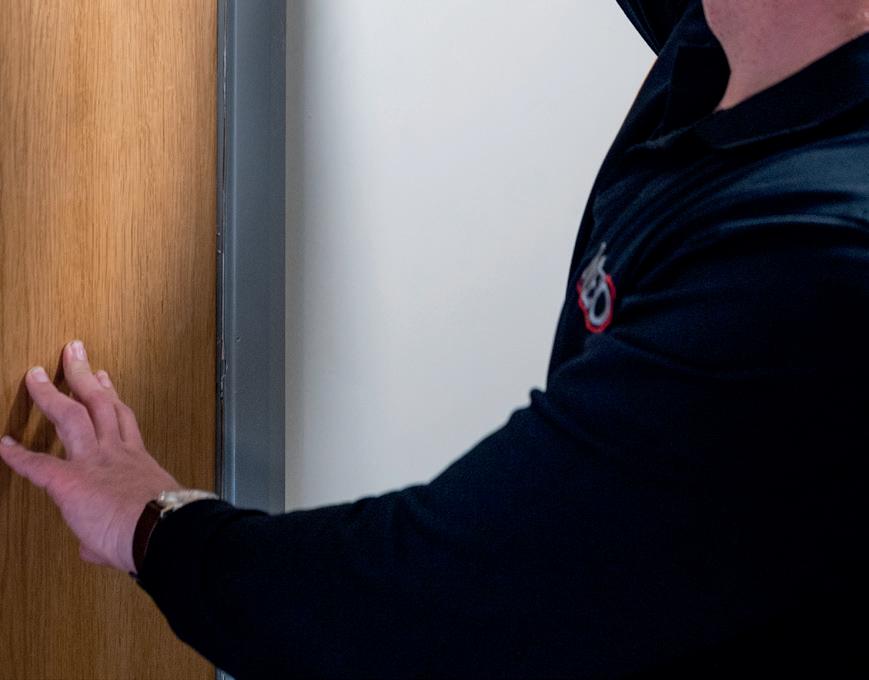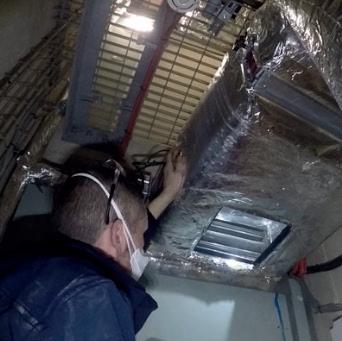Exclusively for FM industry leaders
In this issue:
Robin White, phs Group, talks about the BOG STANDARD campaign to remove the stigma of male incontinence.
Dave Clements, Pestokill – The changing landscape of pest control.

In this issue:
Robin White, phs Group, talks about the BOG STANDARD campaign to remove the stigma of male incontinence.
Dave Clements, Pestokill – The changing landscape of pest control.
Social Impact Director, Pareto FM asks: “Is DEI dead?”
Sponsored by



Innovation, sustainability, and reliability - Green Facilities does commercial cleaning better. It’s our dedication to working with you that sets us apart from our competitors. Our commitment starts before we enter your site – and doesn’t finish until long after.
Leisure
Offices
Museums
Schools
Retailers
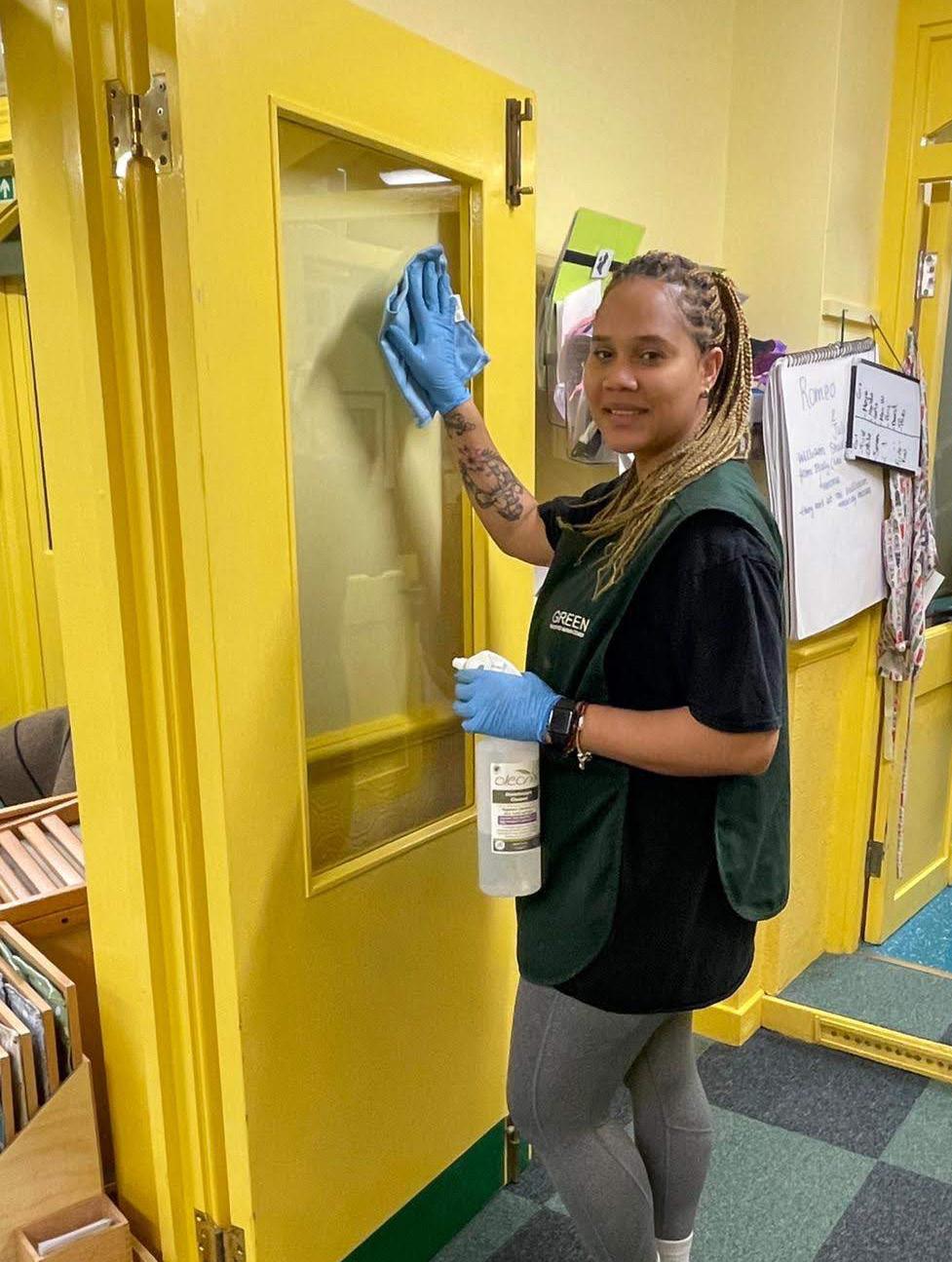
It’s been a crazy month for the team and I – we’ve been busy behind the scenes with our new look newsletter which launched earlier this month. If you haven’t already, make sure you subscribe to stay up to date with all the latest news, interviews and features from across the FM industry.
This month we hear from Emma Wilson, Social Impact Director at Pareto FM about DEI in the workplace, Robin White, phs Group’s Chief Commercial Officer about working to remove the stigma of male incontinence and Dave Clements, Managing Director of Pestokill, who talks about the changing landscape of pest control.
We also have lots more exclusive interviews and features from leading companies across the FM industry. Read on and enjoy!
I hope you find this edition interesting and insightful and as always, if you have anything you’d like to feature or discuss, please drop me a line.
Thank you,
Claire Middleton
claire.middleton@businessdailygroup.co.uk



fmdirector@fmbusinessdaily.com



Recent changes in the United States, led by Donald Trump’s administration, have seen significant rollbacks in diversity, equity, and inclusion (DEI) initiatives. Emma Wilson, Social Impact Director at Pareto FM tells us more
Empowering Clients on Their Net Zero Journey: NuServe Launches
Advanced Carbon Reporting!
All UK businesses are required to reach carbon net zero by 2050, but achieving this goal demands more than ambition– it requires actionable insights and collaboration
Security, sustainability and social value
Security and sustainability may not immediately appear intertwined, but organisations need to collaborate with all supply chain partners to meet ever-looming sustainability goals. Developing decarbonisation strategies, ESG commitments and social value service offerings all strengthen organisational partnerships and business cases. Sharon McLaren, quality and compliance manager, Corps Security, tells us more…
Managing Editor
Claire Middleton
Managing Director Cheryl Ellerington
Published by FM Business Daily, Linacre House, Dark Lane, Braunston NN11 7HU © 2025 FM Business Daily. All rights reserved. Reproduction of the contents of this magazine in any manner whatsoever is prohibited without prior consent from the publisher. No part of this magazine may be used or reproduced in any manner for the purpose of training artificial intelligence technologies or systems. For subscription enquiries and to make sure you get your copy of FM Director please ring 01482 782287 or email fmdirector@fmbusinessdaily.com The views expressed in the articles reflect the author’s opinions and do not necessarily reflect the views of the publisher and editor. The published material, adverts, editorials, images and all other content is published in good faith.
How Cleanology has embraced new technology as an integral part of its DNA
Empowering Clients on Their Net Zero Journey: NuServe Launches Advanced Carbon Reporting!
Sustainable Relocation: Meeting Procurement Standards with Green Innovation
Ede’s – the removal company that’s really going places
Powering the future: Why battery-powered tools are the key to a safer, greener construction industry
How effective hand washing and drying can help curb the spread of HMPV and other infections across the healthcare sector
The Future of Cobot Cleaning
Pest Control – Prevention is Key
How compliance makes organisations perform measurably better
phs Group’s mission to remove the stigma of male incontinence
Security, sustainability and social value

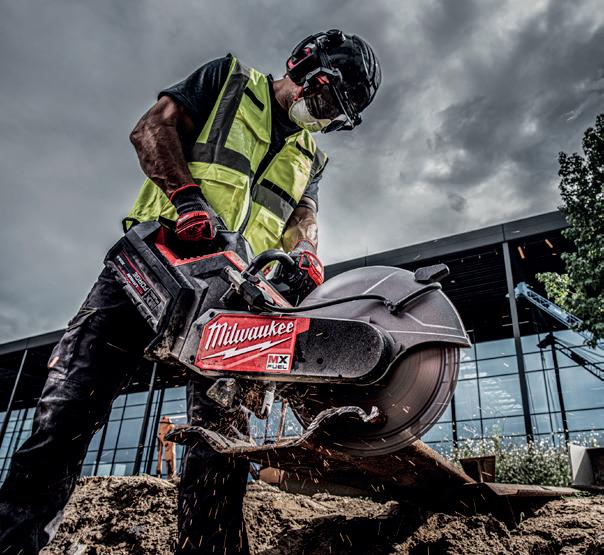

Recent changes in the United States, led by Donald Trump’s administration, have seen significant rollbacks in diversity, equity, and inclusion (DEI) initiatives. Emma Wilson, Social Impact Director at Pareto FM tells us more


In early 2025, new policies were introduced that reversed many of the previous commitments to inclusion, including limiting recognition of gender diversity and cutting funding for workplace DEI programs.
These changes have sparked debate about the future of workplace inclusion and whether DEI efforts are being abandoned. However, instead of viewing this as a setback, businesses have an opportunity to stand out by championing DEI, using it as a way to attract talent, improve productivity, and foster innovation.
Despite political shifts, research continues to show that diverse and inclusive workplaces perform better. A study by McKinsey & Company (McKinsey, 2024) found that companies with diverse leadership teams are 25% more likely to be more profitable than their less diverse competitors.
The Chartered Institute of Personnel and Development (CIPD, 2024) highlights that employees working in inclusive environments report higher job satisfaction, better collaboration, and stronger engagement with their work.
Additionally, according to Deloitte Insights (Deloitte, 2024), businesses with inclusive cultures are six times more likely to be innovative and twice as likely to meet or exceed financial targets.
These findings prove that DEI is not just about doing the right thing morally– it makes clear business sense. Companies that continue to invest in diversity can expect better ideas, improved teamwork, and stronger customer connections.
Under the new policies in the US, many businesses have been forced to scale back or even remove DEI programs due to political pressure and funding cuts.
Trump’s administration has introduced measures that remove genderinclusive policies and reduce legal protections that previously supported diversity in the workplace (The Guardian, 2025).
These changes could lead to a rise in workplace discrimination, reduced opportunities for underrepresented groups, and a potential loss of trust among employees and customers.
However, progressive businesses that continue to support DEI can stand out in this polarised environment.
Despite political shifts, research continues to show that diverse and inclusive workplaces perform better

As consumers and employees increasingly prefer brands and employers that reflect their values, companies that uphold inclusive policies will have a competitive edge.
According to Work Design Magazine (Work Design Magazine, 2024), organisations that actively promote DEI are more likely to attract and retain top talent, especially among younger generations who prioritise inclusivity when choosing employers.
Instead of retreating, companies should take proactive steps to strengthen their DEI efforts. Here are some strategies to help businesses stay ahead:
1. Inclusive Leadership
Leaders should set the tone by embedding inclusivity into company values and decision-making. Offering DEI training and fostering an open culture where employees feel safe to express their views can create lasting positive change (CIPD, 2024).
2. Equitable Hiring Practices
Businesses should continue to ensure fair and transparent recruitment processes that attract a wide range of candidates. Simple adjustments, such as using inclusive language in job adverts and offering flexible interview processes, can make a big difference (Deloitte, 2024).
3. Creating Safe Workspaces
Inclusive design should extend beyond policies to the physical workplace. Providing gender-neutral restrooms, quiet spaces for neurodivergent employees, and ensuring accessibility for all can foster a sense of belonging (Work Design Magazine, 2024).
4. Listening to Employees
Regular feedback and engagement with employees from diverse backgrounds help businesses understand challenges and make meaningful improvements. An inclusive workplace is one where everyone’s voice is heard and valued (McKinsey, 2024).

By staying committed to DEI, businesses can gain a significant advantage in the market. Customers are more likely to support companies that align with their values, and employees are more engaged when they feel respected and included.
Research from Deloitte (Deloitte, 2024) shows that companies with strong inclusion strategies outperform their competitors in terms of innovation, employee satisfaction, and profitability.
Moreover, as regulatory changes continue to evolve in different regions, businesses that lead in DEI now will be better prepared to adapt and meet future expectations.









Conclusion
While political challenges may create uncertainty around DEI, businesses have an opportunity to reaffirm their commitment and show leadership in fostering inclusive workplaces.
The current climate presents a chance to differentiate, attract top talent, and build stronger, more innovative teams.
DEI is far from dead – its value is greater than ever for companies willing to embrace it.
You can explore this subject further in the ‘Is DEI Dead?’ session at The Workplace Event on Wednesday 9th April, 2025.
The Equality Act 2010
The Act prohibits direct and indirect discrimination, and harassment and victimisation. It also prohibits discrimination in relation to something arising from a person’s disability, and creates a duty to make reasonable adjustments for disabled people. Under the Equality Act 2010, there are nine protected characteristics which are; age, disability, gender reassignment, marriage and civil partnership, pregnancy and maternity, race, religion or belief, sex, and sexual orientation.

ECO Property Maintenance is an environmentally friendly and cost-effective way to bundle non-business critical jobs of compatible trades.
It is a simple way to reduce the number of attendance fees and lower your carbon footprint for non-urgent works such as minor repairs or minor decorative fixes.
For more information contact info@msl-ltd.co.uk
Low urgency maintenance issues at the same site are grouped as Eco tasks and stored on the inSYNC portal for up to 21 days.
inSYNC recognises compatible trade tasks and calculates estimated labour timescales to complete.
Any of the following three triggers then apply: A standard priority job is raised - any compatible Eco tasks are bundled to this work order.
Four estimated labour hours are reached to complete compatible Eco tasks - one bundled work order is created
21 days are reached - one bundled work order
By Dominic Ponniah, CEO & Co-Founder of Cleanology

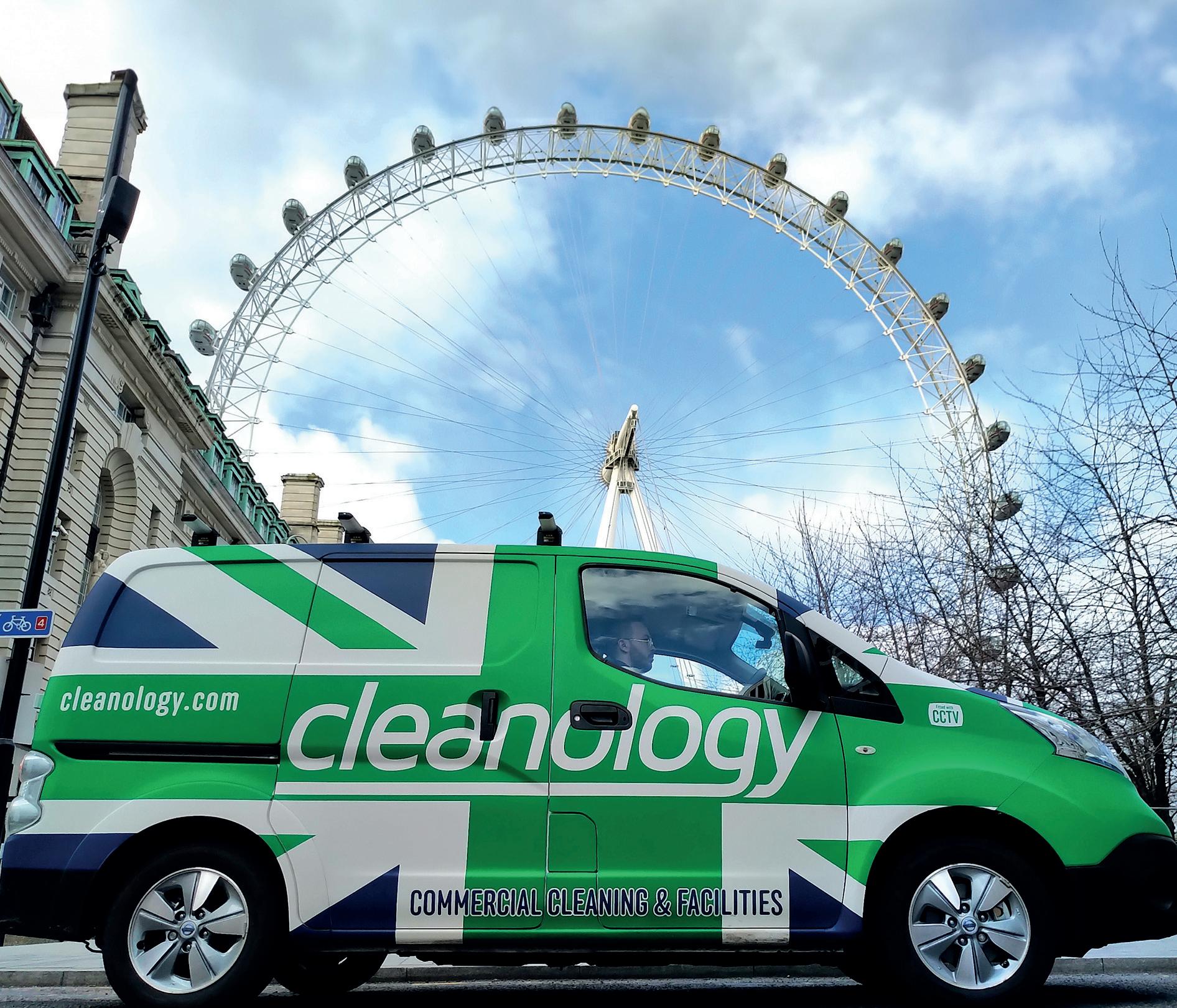
Technology has revolutionised the way commercial cleaning operations are carried out, enhancing efficiency, productivity, and service quality.
By leveraging technological advancements, FM managers are able to optimise cleaning processes, monitor performance, and create safer and healthier environments.
At Cleanology, we’re at the forefront of technological innovation, strategically incorporating cutting-edge solutions across various facets of our operations. We have introduced new platforms throughout the business, enhancing integration and activity management.
Our own platform, Cleancopter, allows our teams to manage tasks seamlessly online, reducing paper reliance and elevating satisfaction for both customers and employees.
In terms of attendance logging, our in-house IT experts have developed a custom app featuring advanced AI facial recognition technology, ensuring protection for lone and night-shift workers, real-time resolution of attendance issues, elimination of fraudulent activity, assured premises security, and client reassurance.
Cleanology’s data-driven, predictive facilities technology – called Cleantelligent – optimises cleaning schedules, based on real-time building usage data.
For example, passive infrared sensors are used to measure usage in each toilet area.
The challenges facing commercial cleaning companies in the wake of fluctuating office occupancy rates are multifaceted
Customers can give instant feedback or log issues and are able to access real-time data on their mobile phone or download it to their desktop.
Every stage of work can be monitored, with cleaners tapping keyrings after cleaning takes place. Alerts are sent automatically when usage thresholds are reached or when users press a button.
Embracing energy-efficient technologies, such as LED lighting, electric vehicles and low-energy equipment, has substantially reduced our carbon footprint, and lowered costs.
For example, our decision to switch our fleet of vehicles to fully electric is saving more than £3,000 a year per vehicle.
This fleet is the exception in an industry that clocks up substantial mileage travelling to client sites. Our entire van fleet in London is 100% electric, saving 5,000 litres of diesel per year – equivalent to 13.5 tonnes of CO 2
There is no road tax or London congestion charge to pay, which saves £8,500 per vehicle, and a massive £51,000-a-year cost reduction overall.
Our staff help customers to meet their own recycling targets and boost recycling. This generates greater volumes of recycling materials.
However, we understand that recycling alone is not enough. So, as well as reducing our own plastic waste, we decided to tackle end markets with the introduction of uniforms made from recycled bottles.
Each shirt is made from two bottles, while the sweatshirts are made from three bottles. This has saved 7,000 bottles from landfill in 2022, while also reducing the need for the resources and energy used to manufacture both bottles and new clothing.
Our recycled uniforms and portion-controlled cleaning solutions were both industry firsts. Together, these initiatives are saving 28,000 bottles from landfill every year.
Cleanology have also advocated chemical-free cleaning for the past 10 years and is now almost chemical-free across its entire portfolio. Over-dosing of cleaning chemicals is a problem in our industry.

While adding an extra cupful of solution may not seem significant, if you multiply that across the 450,000 people across industry, the impact becomes critical.
Our entire van fleet in London is 100% electric, saving 5,000 litres of diesel per year – equivalent to 13.5 tonnes of CO 2
In finding new and interesting ways to work cleaning firms can adapt to changing needs
To tackle this issue, Cleanology was the first in Europe to introduce portion-controlled biological cleaning sachets. Since 2017, we have saved over 144,000 litres of cleaning solution.
Since switching to portion-controlled biological cleaning sachets, we have cut plastic bottle usage from 22,000 to just 500 PET bottles a year. We have now saved a staggering 132,000 plastic bottles from being used since we launched this initiative.
Our focus has now shifted to deal with the enormous plastic waste created by mop heads with plastic sockets. Given we use over 135,000 mop heads a year, we are now using mop heads where you only change the strings, not the plastic.
The challenges facing commercial cleaning companies in the wake of fluctuating office occupancy rates are multifaceted.
There are many operational, financial, and strategic considerations. But in finding new and interesting ways to work –including the use of time-saving technology – cleaning firms can adapt to changing needs.
The commercial office sector will continue to evolve, and the role of commercial cleaning companies will remain an integral part of ensuring people stay safe and well in the workplace.
Visit: cleanology.com/services/office-cleaning/

All UK businesses are required to reach carbon net zero by 2050, but achieving this goal demands more than ambition– it requires actionable insights and collaboration
Georgina Lockwood, Sustainability Manager at NuServe, tells us about NuServe’s commitment to supporting their clients on this journey, and how they have elevated carbon reporting to new heights, offering innovative and comprehensive solutions that enable businesses to take charge of their emissions and drive meaningful change.
NuServe has always been a trailblazer. As the first B Corp-certified facilities company in the UK, we’ve set a benchmark for responsible business practices.
Our new carbon reporting service continues this tradition by delivering precise, verified data rather than relying fully on assumptions or estimates.
Facility companies like ours fall under Scope 3, Category 1 (Purchased Goods & Services) of a client’s carbon footprint. Traditionally, carbon reports rely on spend-based calculations and estimates, which can lead to inaccuracies.
NuServe goes further by prioritising physical data, enabling more effective and trustworthy carbon management. After all, as Albert Einstein said: “Assumptions are made, and most assumptions are wrong.”
How Carbon Reports Benefit You
NuServe’s carbon reports are designed to empower our clients with actionable insights, whether you’re a Sustainability, Facilities or Office Manager:
Verified Accuracy for Sustainability Reporting: Our reports provide Sustainability Managers with precise, independently verified carbon figures for inclusion in annual reporting. No greenwashing – just reliable data that aligns with GHG Protocol standards.
Simplified Insights for Operational Decision-Making: For Facilities & Office Managers, our reports translate technical data into actionable steps, with guidance from NuServe’s Account Managers.
This helps identify sustainable alternatives, manage consumables more effectively, and make informed decisions to reduce site emissions.
Biannual Reporting for Proactive Management:
Unlike traditional retrospective reports, NuServe’s biannual updates allow clients to actively monitor and manage their carbon footprint throughout the year. This proactive approach is particularly valuable for areas like business travel and consumables, helping to reduce emissions while saving time and money.



To achieve net zero, businesses must collaborate with their supply chains. At NuServe, we’re already monitoring 90% of our supply chain emissions, enabling us to identify high-impact areas and work with suppliers to reduce their carbon footprint. This not only drives our own sustainability efforts but also supports suppliers in starting their net zero journey
To achieve net zero, businesses must collaborate with their supply chains
As demand grows, we’re also laying the groundwork for Life Cycle Assessments (LCA), providing even deeper insights into product and service emissions.
NuServe’s bespoke carbon reports help clients:
Enhance their sustainability credentials with accurate, verified data.
Reduce emissions proactively, saving resources and improving efficiency.
Build long-term resilience in the face of increasing regulatory and stakeholder demands for carbon accountability.
Join us in leading the charge toward a sustainable future. With NuServe’s support, your net zero journey doesn’t just comply with regulations – it sets a new standard for innovation and responsibility.
Contact NuServe today to learn more about our advanced carbon reporting solutions and how they can benefit your business.

With sustainability at the core of new procurement laws, facility managers must now ensure their suppliers align with environmental targets. Awarding contracts based on sustainability is no longer a preference—it’s a requirement, shaping the future of responsible business operations.
At Ede’s, a family-owned relocation specialist with over 150 years of excellence, Seven times winner of the BAR commercial mover of the year, we are leading the way in sustainable logistics. Recognising the urgency of reducing carbon emissions, we have transitioned our entire fleet to HVO (Hydrotreated Vegetable Oil) fuel, a clean, renewable alternative to diesel that significantly lowers our environmental impact.
Taking our commitment further, we have also introduced two electric vehicles (EVs) into our fleet.
These additions mark another step towards a zero-emission future, enhancing our ability to provide environmentally responsible relocation services without compromising efficiency or reliability.
For facility managers, this presents a clear advantage: compliance with evolving sustainability regulations while partnering with a relocation provider actively driving positive environmental change. In addition to our green initiatives, we offer seamless, cost-effective relocation solutions, utilising advanced tracking systems and innovative space planning to improve efficiency and reduce costs.
As the procurement landscape shifts towards sustainability, facility managers must prioritise suppliers who embrace long-term environmental responsibility. By choosing Ede’s, you ensure compliance, efficiency, and a shared commitment to a cleaner, greener future.
Partner with Ede’s and move responsibly, contact us for more of our services and our complete holistic approach to moving.

When it comes to removal companies, you don’t get many more well-established than Ede’s
Afamily-owned business with roots dating back more than 150 years to 1869, the company has evolved from a small operation involving just a horse and cart and a greengrocer named William Ede, to the award-winning, commercial relocation company it is today.
Specialising in reliable and high-quality removals, relocations, and storage solution services, Ede’s is an undisputed leader within the UK removals sector whose impressive longevity is a testament to its adaptability and unwavering commitment to quality and customer care.
So, what’s it like to run a well-established removal and relocation business such as Ede’s? Jonathan Smith, Ede’s CEO, tells us all about it.
Ede’s daily operations are very varied. We manage office relocations, IT moves, storage solutions, and much more. Whether we’re working with iconic institutions like the British Museum or streamlining office transitions, every single task we undertake reflects our dedication to precision, sustainability, and above all, client satisfaction.
As CEO, my role involves steering Ede’s into the future while making sure we continue to honour our rich heritage. I focus on strategic growth, ensuring operational excellence, supporting our incredible team, and strengthening client relationships, which are so important to maintain a well-respected and thriving business.
Like any industry, the removals and relocation industry faces many challenges on a day-to-day basis. Fluctuating demand, environmental sustainability pressures, and ever-evolving client expectations are just some of those challenges.
The important thing is not avoiding challenges, but how you navigate them as a business.
At Ede’s we navigate these challenges by embracing innovation and implementing eco-friendly solutions such as HVO fuel and leveraging technology for seamless operations. Continuous investment in staff training and client engagement are important ways by which we ensure we stay ahead of the competition.
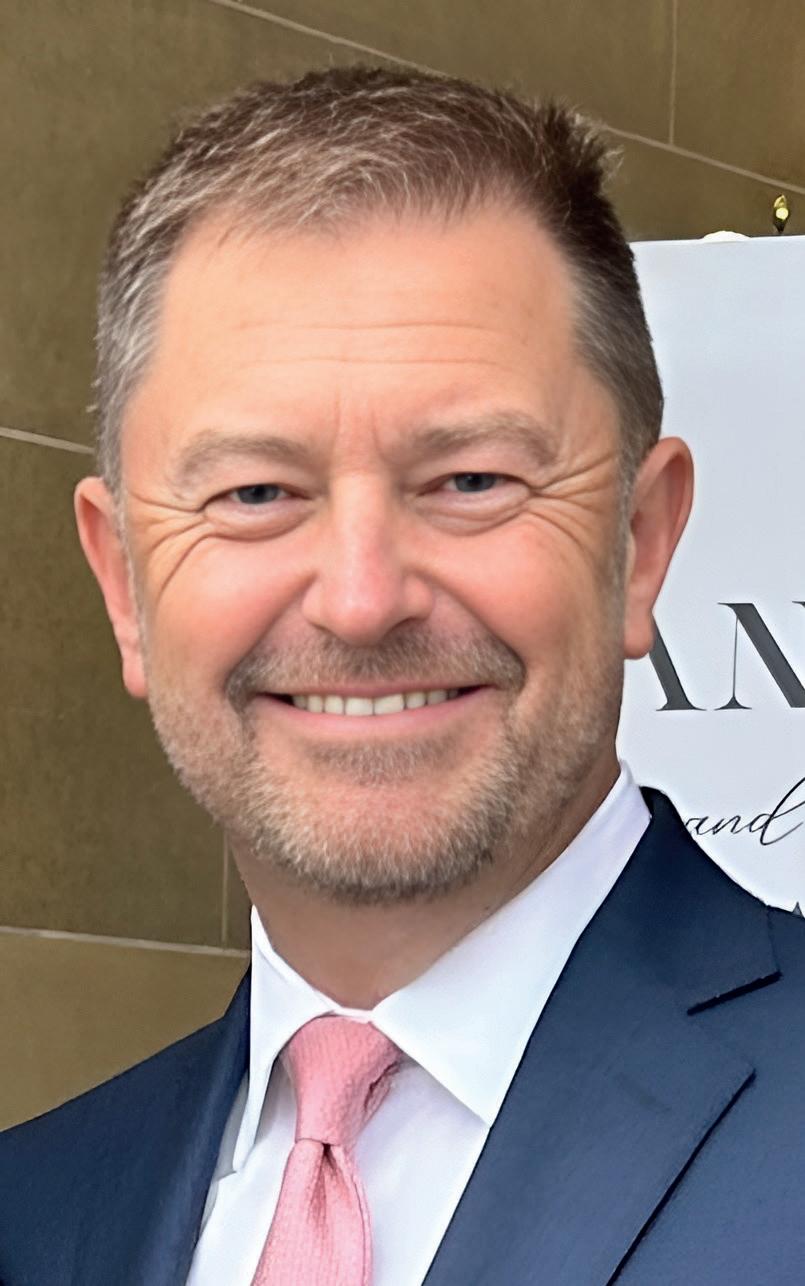

Looking ahead to the future, I think there will be several notable changes within the industry. Particularly over the next two to three years, I foresee an increasing emphasis on sustainability, technology-driven solutions, and client customisation as the industry standard evolves further and further.
And how will we adapt to these changes? Ede’s will continue to lead by integrating advanced technologies, refining sustainable practices, and remaining flexible to emerging trends.
Ede’s history is long, but its future will be longer!
Our steadfast focus on people – both clients and employees – will be central to our adaptation strategy.
This industry is wonderful to work in. I love the people - the clients we serve, the talented team I work with, and the satisfaction of seeing challenging projects come to life. It’s immensely rewarding to lead a company with such a storied legacy and a very promising future.
Ede’s is more than a business; it’s a family that is built on trust, expertise, and care. I’m so proud of what we’ve achieved and excited for the opportunities that lie ahead. We’re here for the long haul, ready to grow, innovate, and continue exceeding expectations.
We are not looking to be the biggest. We want to be the best. We are focused on building a robust and stable business that will be there for our clients and staff not only now, but far into the future. In order to do that we need to put the right people in the right environment and empower them to do their job to the very highest standards.
Results need to be felt by everyone - all of the stakeholders, be they owners, clients or colleagues.
Ede’s history is long, but its future will be longer!
the
For decades, petrol-powered tools have been a staple on construction sites. These tools have been essential for getting the job done, but with growing awareness of the health and environmental risks associated with petrol emissions, the construction industry is facing a pivotal moment
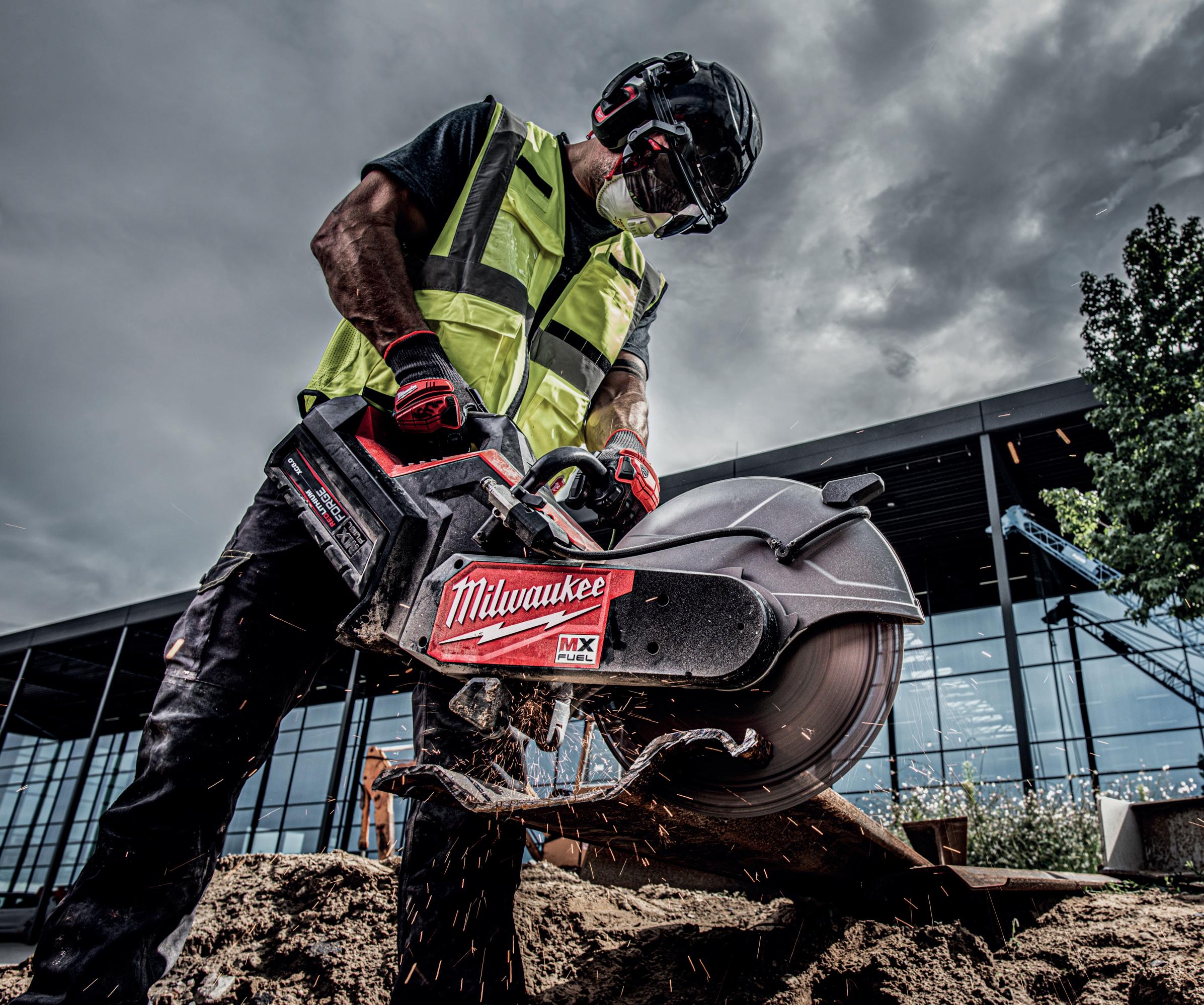
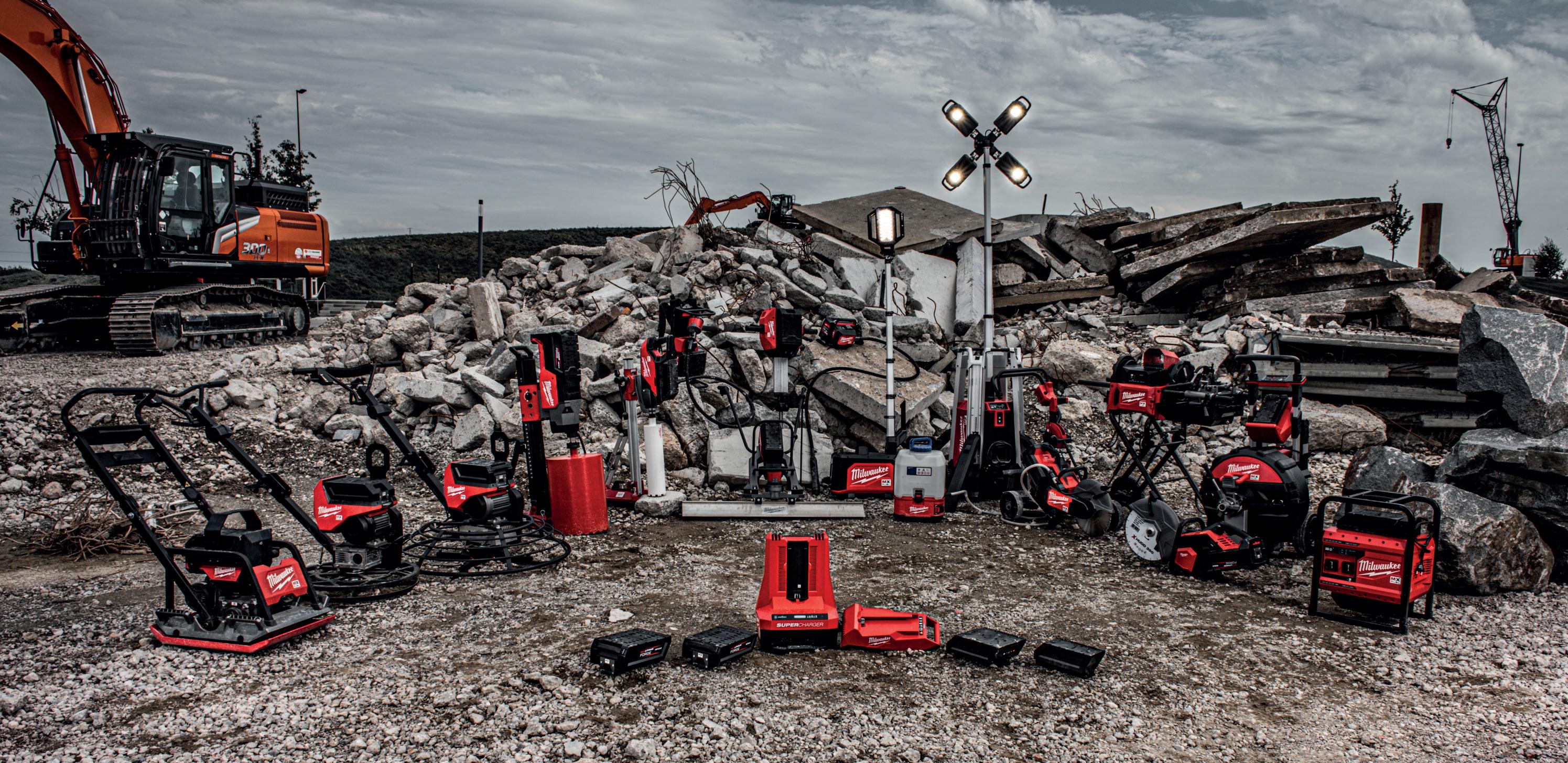
The continued reliance on petrol-powered equipment poses significant risks, not only to workers but also to the environment, as harmful emissions such as benzene and carbon monoxide degrade air quality and contribute to a range of health problems.
As the demand for healthier and more sustainable practices increases, the industry now finds itself at a crossroads: it’s time to make the shift to cleaner, more efficient tools. Kim Ehrler, MILWAUKEE® Product Manager, Power Tools EMEA, tells us more.
The hidden costs of petrol-powered tools
The dangers of prolonged exposure to petrol fumes are welldocumented. These emissions are linked to a variety of serious health conditions, including heart disease, lung cancer, respiratory issues, and even neurological disorders. Fine particulate matter (PM) emitted from petrol-powered equipment is a particular concern, as it can lead to the development of chronic conditions like emphysema and asthma. These health problems not only affect workers on construction sites, but also the general public, particularly in urban areas where construction activity is concentrated.
A recent study by the UK Health Forum and Imperial College London highlighted just how significant the impact of reducing fine particulate pollution could be. The research found that a reduction of just 1 μg/m³ in air pollution could prevent tens of thousands of health issues, including coronary heart disease, strokes, asthma, and lung cancer over an 18-year period.
Additionally, data from the European Environment Agency reveals that nearly 97% of Europe’s urban population is exposed to fine particulate matter levels that exceed the health-based guidelines set by the World Health Organisation (WHO).
These alarming statistics reinforce the importance of shifting away from petrol-powered tools. The move to cleaner alternatives is not only beneficial for workers’ health but also for improving air quality in urban areas, which will have far-reaching benefits for public health.
A growing awareness and shift towards sustainability
The global awareness of environmental and health issues has sparked significant changes in many industries, and the construction sector is no exception. Sweden and Denmark are leading the charge in tackling the issue of petrol emissions. Sweden’s ‘Fossil Free Sweden’ initiative is one example of how governments are pushing for stricter emission standards on equipment, making it more difficult for older, less-efficient petrol-powered models to remain in use.
Similarly, Denmark’s ‘Green Public Procurement’ program prioritises the purchase of environmentally-friendly construction equipment and machinery by public institutions, encouraging a shift towards sustainable practices.
While governmental policy changes are important, one of the biggest catalysts for change has been the rapid advancements in battery technology. In the past decade, battery-powered tools have evolved significantly, offering the power and performance necessary to meet or even exceed the capabilities of their petrolpowered counterparts. With improvements in battery capacity, efficiency, and run-time, these tools have become a safer, cleaner, and more viable option for construction professionals.
The global awareness of environmental and health issues has sparked significant changes in many industries, and the construction sector is no exception

The benefits of battery-powered tools go far beyond environmental considerations. On busy construction sites, the elimination of long extension cords provides greater mobility, flexibility, and convenience. With no need to worry about tangled cables or tripping hazards, workers can move more freely and focus on the task at hand. Additionally, cordless tools reduce the time spent managing cords, which leads to improved site organisation and efficiency.
Battery-powered tools also have significant safety advantages. Workers are less likely to trip over, cut through, or become entangled in cables, which can be particularly dangerous when working at heights or in tight spaces. Moreover, many batterypowered tools feature rapid shut-off capabilities, which immediately power down the tool in emergency situations, preventing further injuries. In contrast, petrol-powered tools require manual intervention to switch them off, which can be dangerous if left running and presents an additional risk to those working nearby.
Despite these clear advantages, some misconceptions around battery technology persist, particularly around performance and run-time. These misconceptions have delayed the widespread adoption of battery-powered tools in construction. However, as more construction companies embrace the benefits of battery-powered equipment, the industry is beginning to see a significant shift.
Battery-powered tools are becoming increasingly popular and are now seen as a worthwhile investment. A recent survey of over 3,000 European construction workers, conducted by MILWAUKEE®, revealed that nearly all respondents felt safer using battery-powered tools compared to their petrol-powered counterparts. This shift in perception is largely due to the impressive advancements in battery technology, which now allow tools to perform at levels comparable to, or even exceeding, the capabilities of petrol-powered equipment.
MILWAUKEE®’s REDLITHIUM™ FORGE™ batteries, designed for the M18™ and MX FUEL™ systems, are a prime example of this leap in performance. These batteries offer increased capacity, longer run times, and more power, enabling tools to handle even the most demanding tasks that were once only achievable with petrol-powered tools.
The increase in power and torque ensures that users can complete jobs more efficiently, with fewer interruptions for refuelling or battery charging.
The transition to battery-powered tools is already underway, and the benefits are becoming increasingly evident. Not only do these tools offer improved safety, enhanced productivity, and reduced noise, but they also provide a sustainable solution for the industry. The environmental benefits—such as reduced emissions, improved air quality, and a smaller carbon footprint—make the switch to battery-powered equipment a priority for businesses committed to sustainability.
As battery technology continues to advance, costs will decrease, making these tools accessible to businesses of all sizes. The range of battery-powered equipment is also expanding, enabling the industry to tackle a boarder array of tasks with cordless efficiency.
The transition from petrol-powered tools to battery-powered equipment is no longer a matter of “if,” but “when.” For construction companies committed to sustainability, the benefits are clear: reduced emissions, healthier workers, and a smaller carbon footprint.
By embracing battery-powered tools, the construction industry can lead the charge toward a safer, cleaner, and more sustainable future. The time to act is now—because the future of construction is cordless.



In recent months, cases of human metapneumovirus (HMPV) – a flu-like disease first identified in 2001 – have surged across the UK, following a suspected outbreak in China

According to the latest data from the UK Health and Security Agency (UKHSA) , the percentage of people testing positive for the virus – which can lead to bronchitis, pneumonia, or upper and lower respiratory infections – increased significantly during the third week of December and remained at this higher level the next week.
This, combined with the winter flu crisis that the UK is currently battling, has placed intense pressure on hospitals, with healthcare workers struggling to keep up with the influx of new patients coming through their doors.
Here, Colin Townsend, Sales Manager, Mitsubishi Electric Hand Dryers, tells us more about the problem and how effective hand washing – and drying – can help solve it.
As cases are expected to continue climbing over the following weeks and months, health officials have recommended that people take sensible precautions to avoid catching or spreading HMPV, and other respiratory illnesses.
One of the key recommendations is that hands are washed regularly and thoroughly, given that contact between surfaces is among the main ways the virus is spread. This not only means ensuring that hands are washed for at least 20 seconds to maximise the amount of bacteria that’s removed, but also that they are completely dried.
This is especially vital because any water residue left on the hands can effectively act as a breeding ground for additional microorganisms, or allow for bacteria to be more easily transferred to other surfaces, with research showing that wet hands are 1,000 times more likely to transmit bacteria between surfaces than dry ones.
Despite this, research shows that less than half the population dry their hands after washing. Of those who do, many spend well below 20 seconds drying, meaning far fewer bacteria are removed than otherwise would be. This is particularly alarming in the context of healthcare settings such as hospitals, where workers typically have between 39,000 and 4.6 million bacteria on their hands at any given time.
Part of the reason for this comes down to the failure of many healthcare workers to perform appropriate hand hygiene, with 40% of healthcare-associated infection (HAI) cases caused by crossinfection, which often occurs via the hands through contact between workers or other patients.
Considering such infections are a major cause of morbidity and mortality, the importance of practising correct hand hygiene in hospitals and other public facilities is clear.
It is not just a failure to adequately dry hands that can contribute to the spread of infection; the method of drying is another pivotal factor.
While paper towels and warm air hand dryers are both common drying methods in public settings, they can cause a 150% rise in colony-forming units (CFUs), meaning their use can actually increase the level of bacteria present on the hands or in the surrounding air.
Why Air Curtain Dryers are the Solution
This is where high-speed air curtain dryers can prove highly effective at limiting the spread of infection. After all, with some of the most advanced air curtain dryers on the market, there is no increase in the CFUs created, and no additional bacteria is transferred into the atmosphere or onto nearby surfaces.
This translates to potentially <4 units of disability adjusted life years (DALYs) – which measure overall disease burden in the number of years lost due to ill-health, disability, or early death – compared with 12 and 13 units for paper towels and warm air hand dryers respectively.
Moreover, research shows that paper towels and warm air dryers typically affect human health roughly three and 3.5 times respectively more than air curtain dryers.
As such, the use of high-speed air curtain dryers in healthcare settings can significantly limit the number of HAIs caused by physical contact, or through airborne infection.
On top of this, these dryers operate far more efficiently than either paper towels or warm air dryers, which typically have a drying efficiency of between 30 and 40 seconds.
With air curtain dryers, meanwhile, the drying time can be cut down to between nine and 11 seconds.
This time saving is particularly valuable considering how many people don’t dry for a sufficiently long period to achieve full dryness, if they dry at all. By shortening the process to between just nine and 11 seconds, high-speed air curtain dryers can boost drying compliance considerably without bacteria levels rising, or users having to spend the 20 seconds or more that they are otherwise advised to dry for.
Besides their speed and cleanliness, air curtain dryers can also be far more durable than their counterparts. For some of the most sophisticated air curtain dryers, the average product life can be nearly three times higher than other models, surviving for upwards of one million uses.
This means that the impact on environmental sustainability – and, therefore, directly on human health – that these systems have is even lower than with dryers that do not last as long, and need to be replaced more frequently as a result.
Hands are washed for at least 20 seconds to maximise the amount of bacteria that’s removed
Research shows that less than half the population dry their hands after washing. Of those who do, many spend well below 20 seconds drying
Furthermore, some high-end dryers now come equipped with clean air filters, which work far more efficiently than more standard High Efficiency Particulate Air (HEPA) filters.
This is because HEPA filters are prone to rapidly becoming clogged, not only severely affecting the hand dryer’s efficiency by drastically reducing the airflow, but also diminishing the hygiene effectiveness of the filter over time.
Adding to this, HEPA filters tend to cause large loads on the motor, increase noise and power consumption, and are both expensive and difficult to replace.
Clean air filters, meanwhile, are considerably cheaper, don’t contribute to noise generation or impact motor performance, and effectively remove – or otherwise kill – even tiny pieces of dust and bacteria.
As such, air curtain dryers with such features that are installed in public settings aren’t just more advantageous from a health and safety perspective, but from a cost-effectiveness one too.
Given the importance of proper hand washing and effective hand drying, those responsible for managing public facilities should consider how implementing high-speed air curtain dryers can simultaneously make the hand drying process significantly more efficient and effective, thereby providing a much-needed boost to hand hygiene compliance.
As cases of HMPV continue to rise across the UK, the use of such dryers can not only have a transformative effect in reducing the number of new admissions to hospitals, but also allow healthcare workers to limit the number of HAIs that are caused by cross-infection, thereby bringing morbidity and mortality rates down markedly.
The impact that air curtain dryers can have is hugely significant, and their cost-efficiency, coupled with the ease with which they can be installed, make them a crucial and highly-effective line of defence against the threat posed by emerging and evolving diseases.
For more information on Mitsubishi Electric’s range of hand drying solutions, please visit wave.mitsubishielectric.co.uk

FM is evolving... so are we! As part of our new look, Business Daily will provide smarter, more targeted news and insights three times per week, on Mondays, Wednesdays and Fridays.
Three per week
• Monday: hard services and construction focus
• Wednesday: soft services focus
• Friday: a combo of the week’s biggest stories, video interviews and exclusive features from across the FM industry
As our name – FM Business Daily – suggests, we’re still updating our website every single day with all the latest stories and updates from all the FM sectors. Check it out to stay in the loop!
We hope you are as excited as we are about the new look FMBD newsletter, and we’d love you to get in touch if there’s anything you’d like to discuss or feature in an upcoming issue.
Subscribe here

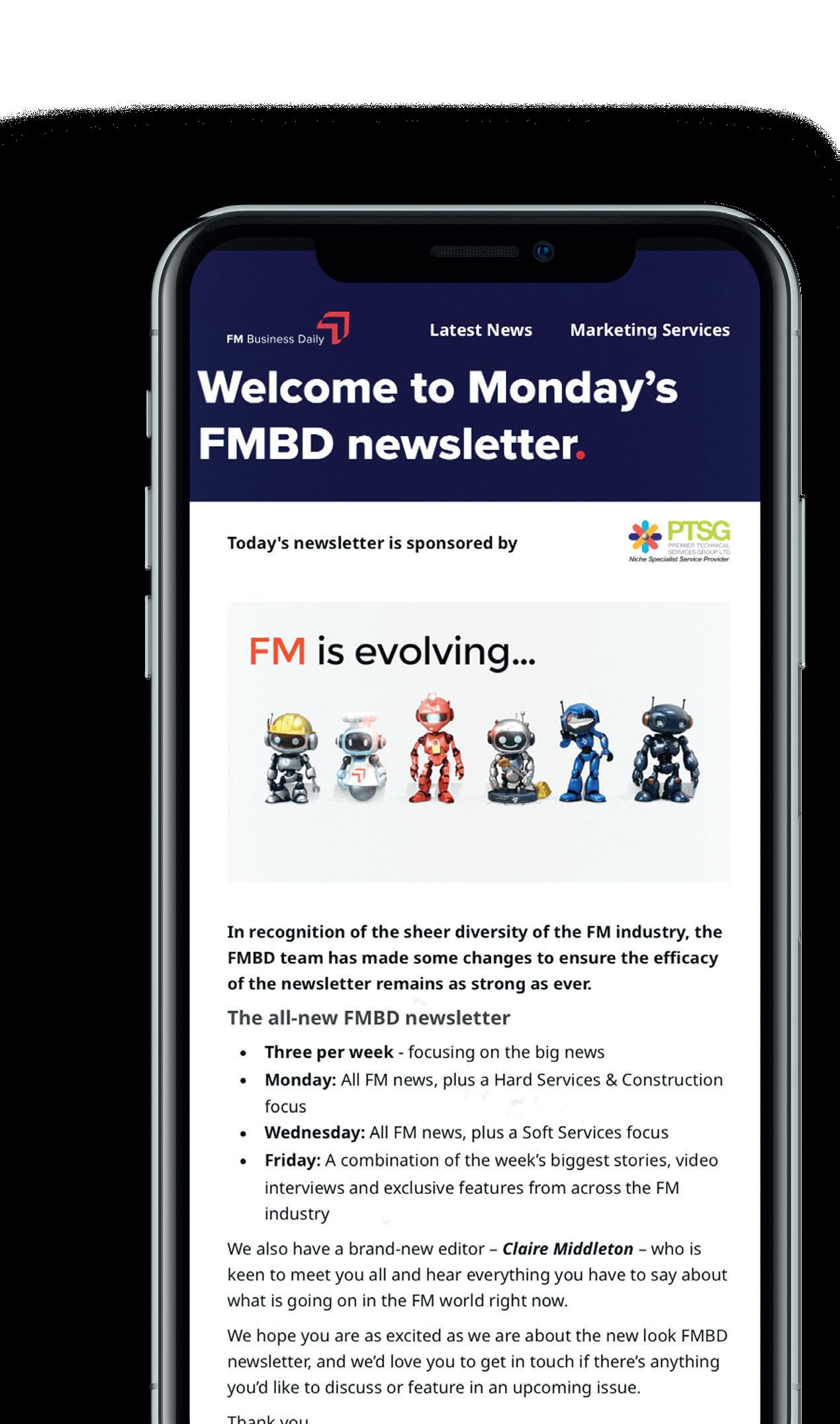
In recent years, collaborative robots, or ‘cobots,’ have become increasingly important to the commercial cleaning industry. To shed more light on the subject, Bradley Reames, Managing Director at Peartree Cleaning, explains all
Unlike traditional industrial robots, which require isolation from human workers, cobots are designed to safely work alongside people in various tasks, augmenting human capabilities rather than replacing them.
In commercial cleaning, cobots can perform repetitive, timeconsuming, freeing cleaning operatives to focus on higher-value activities. However, like any new technology, there are several pros and cons that need to be considered before including cobots in our strategies for 2025.
Automating labour-intensive tasks
As a leading commercial cleaning company, technology is crucial to our business. We’ve fully embraced new and innovative cleaning solutions that deliver efficiencies for us and our clients, and there is no doubt that cobots can help us to achieve these efficiencies by automating the most repetitive and timeconsuming tasks. We’ve recently invested over £20,000 in new ZAKO X1000 cobots to use specifically at our open plan office contracts, meaning we can free our existing workers to take on more value-adding tasks while the cobots look after the large space floor cleaning.
However, for other commercial cleaning companies like us who specialise in office cleaning, cobots offer limited operational benefits. While they are excellent at performing repetitive and structured tasks, they struggle with real-world environments. Cobots can’t open doors or navigate complex environments like an office with obstacles like chairs, cables and clutter. They are also significantly slower than people and lack the dexterity to perform a number of simple cleaning tasks such as wiping down surfaces and edges, cleaning windows, or emptying bins which require fine motor skills and adaptability – tasks that our cleaning operatives perform on a daily basis.
For many of our clients our cleaning teams have worked at their offices for several years and have formed great working relationships with their employees. Our people often address specific ad-hoc customer needs, respond to questions, and provide assistance beyond their daily cleaning duties. Cobots, while efficient, will always lack the human touch.
As we have found, cobots represent a significant upfront cost which many small to mid-sized cleaning companies may struggle to justify. These costs stem from the advanced sensors, software, and safety mechanisms needed to ensure cobots can work safely alongside humans. Additionally, initial setup, programming, and training expenses add to the upfront investment. While cobots are generally easier to program than traditional industrial robots, they still require skilled labour to integrate them into existing workflows. Despite these high initial costs, cobots can offer a positive return on investment over time by increasing efficiency, reducing labour costs, and enabling flexible automation. However, for commercial cleaning companies with limited capital, the initial expense remains a significant challenge, potentially delaying their adoption of cobot technology.
Cobots generally consume less energy than traditional industrial robots, which makes them an eco-friendlier option for many businesses. However, despite their efficiency, the environmental impact of cobots still includes the energy required for their production, as well as the materials used, which often include metals and plastics. And although they can potentially reduce the use of cleaning chemicals and water, cobots require electricity or batteries to operate. This is a big consideration for businesses who have committed to reduce their energy consumption or carbon footprint.
While cobots are generally easier to program than traditional industrial robots, they still require skilled labour to integrate them into existing workflows

The key to success for commercial cleaning companies lies in finding the right balance between automation and people. Peartree is wholly committed to using technology to help us work smarter, shown by our recent investment in ZAKO X1000 and our bespoke quality management system.
This system – Peartree 360, fully revolutionises service tracking for our clients, allowing them to gain access to real-time data encompassing various aspects of their account such as health and safety, sustainability, quality audits, management visits, PPMs, staff training records and invoicing.
As technology continues to advance, cobots will likely play a more prominent role in commercial cleaning. However, whilst they can arguably improve efficiency in certain tasks, at the moment they come with eye watering investment costs and more
importantly for us reduced flexibility in environments that we specialise in. So, while they are unlikely to replace cleaning operatives soon, cobots can be a valuable tool in supporting them. By automating repetitive tasks and enabling human workers to focus on more complex responsibilities, we believe they can help cleaning companies to create safer, cleaner, and more sustainable environments for everyone.
Pestokill’s roots go back to 1985 when Dave Clements started out on his own as a ‘man in a van’. Four decades and an acquisition later and Pestokill is the UK’s largest independent pest controller

With qualified technicians local to every town and city in England, Scotland, Wales and Northern Ireland, Pestokill is a wellestablished business proud of the solid reputation they’ve built up over the years.
Dave Clements, Managing Director of Pestokill, took some time out recently to chat to FM Director about the company’s journey so far, the transition from traditional pest control methods to more digitally-led strategies, and what facilities managers should keep in mind when it comes to protecting their buildings from pests.
“I founded the company by myself back in 1985,” began Dave. “It grew steadily and by 2020 we had 260 staff spread across the UK. Then the COVID-19 pandemic hit and brought with it lots of changes within the industry.
Like many companies, we were concerned about the impact those changes would have on the future of the business. After significant discussion, it was eventually decided that it made good sense to be acquired by ANTICIMEX, a Swedish pest control company with a rich history dating back to 1934.”
Since the acquisition, Pestokill has evolved in its pest control practices, now using digital technology to provide a more preventative approach.
“We are a commercial pest controller dealing with preventive measures,” explained Dave. “Traditionally, pest control was basically tempting the pests in, letting them breed for a few weeks until we knew they were there and then killing them with poison.
“That’s now changed. Today we use digital devices to monitor buildings 24/7 and to spot any pest entry.

“We know within five minutes if a mouse or a rat has entered anywhere in the building and we’re able to deal with that one –without poison - before it’s had chance to breed and multiply.”
Speed is of the essence in pest control with one pair of rats producing up to 1,000 babies in just one year. In addition, one mouse can produce between 60 and 80 droppings in one day, and so from a hygiene perspective, it’s vital to catch them as soon as possible. Thanks to these new technology-driven methods, pest controllers are now able to help facilities managers do just that.
As with any industry, the pest control sector is not without its own unique challenges. So, what challenges are keeping Dave and the team on their toes at the moment? “We are at constant threat from pests,” Dave said. “There are more and more invasive species being found in different countries.
“There are different flies and insects that are arriving in countries where they’ve never appeared before. This means that we’re now not only dealing with traditional pests, but we’ve now also got invasive species from around the world to content with.
“Take the Asian Hornet for example. It’s a huge wasp that attacks other wasps and bees usually found in mainland Europe that’s now invading parts of the UK. We now have to factor them into our pest control strategies and be as prepared as possible. There’s always another pest looking to take advantage of humans and our inability to protect ourselves.
“Apart from that, probably the biggest challenge we have right now is educating our clients; getting them to trust that the conventional methods that have been used for the last 30 years aren’t working, and that they can be done better with technology,” Dave said.
We are a commercial pest controller dealing with preventive measures

“It can be tricky getting the clients, accept and adopt digital systems when they’ve always been used to it being done one way.
“But it’s backed up by logic and we are steadily winning clients over on what we’re doing because not only are we solving problems we couldn’t solve in the past, but we’re also getting to the root of the problem - finding pests earlier before they can become a real problem.”
What can facilities managers do?
So, what can facilities managers do to help in the fight against pests? It’s fairly simple according to Dave. “Facilities managers need to be aware of what pests can use to their advantage and then guard against it.
“They should regularly walk around their building to check out any holes, gaps or voids that could potentially provide an entrance to a pest. Keep in mind that a mouse only needs a hole as wide as a pen to get in!
“They should also remember that food scraps and waste are pure temptation for mice and rats and should remind all occupiers of their building to put any food away securely to avoid pests turning up for a feed.
“We’ve got to be smarter than the pests. We have to try to prevent them in the first place or detect them as early as possible.”
For more information, please visit new.pestokill.co.uk
Facilities managers need to be aware of what pests can use to their advantage and then guard against it
Keep your space pest-free, the smart way.
Pestokill’s intelligent ‘Anticimex Smart’ system detects and predicts infestations before they occur. Eco-friendly rodent control for your business. No more mouse damage clean ups.


It is tempting for organisations to think of compliance as a chore that must be dealt with in order to meet their legal requirements. But those who embrace compliance, open their business doors to a host of benefits


As one of the industry’s leading compliance specialists for the built environment, Premier Technical Services Group Ltd has been helping organisations in all sectors to improve their buildings and the working lives of their users for many years.
What is compliance?
In facilities management, compliance means ensuring all systems and equipment within a building, from fire safety to electrical appliances and wiring, building fabric, power generators and pumps to water hygiene, conform to the latest industry standards. This is a legal requirement as it ensures these systems are fit for purpose so that a building is safe to use. That is always the priority. In keeping their buildings are compliant, organisations remain on the right side of the law, avoiding potentially expensive and damaging consequences. But what are the other advantages?
The benefits beyond the legalities SFG20 is the definitive standard for planned maintenance. It enables facilities managers, building owners, contractors and consultants to stay compliant.
In doing so, they vastly reduce the risk of any incidents occurring that could lead to legal action. Many insurance providers also require proof of compliance with building regulations.
Health and safety is the key. By ensuring compliance, organisations are making the health and safety of their people and everyone else who visits their premises part of their culture.
It is the ethical course of action to safeguard employees, visitors and tenants from potential hazards including fire and electrical risks, poor indoor air quality or hazardous materials.
By ensuring compliance, organisations are making the health and safety of their people and everyone else who visits their premises part of their culture
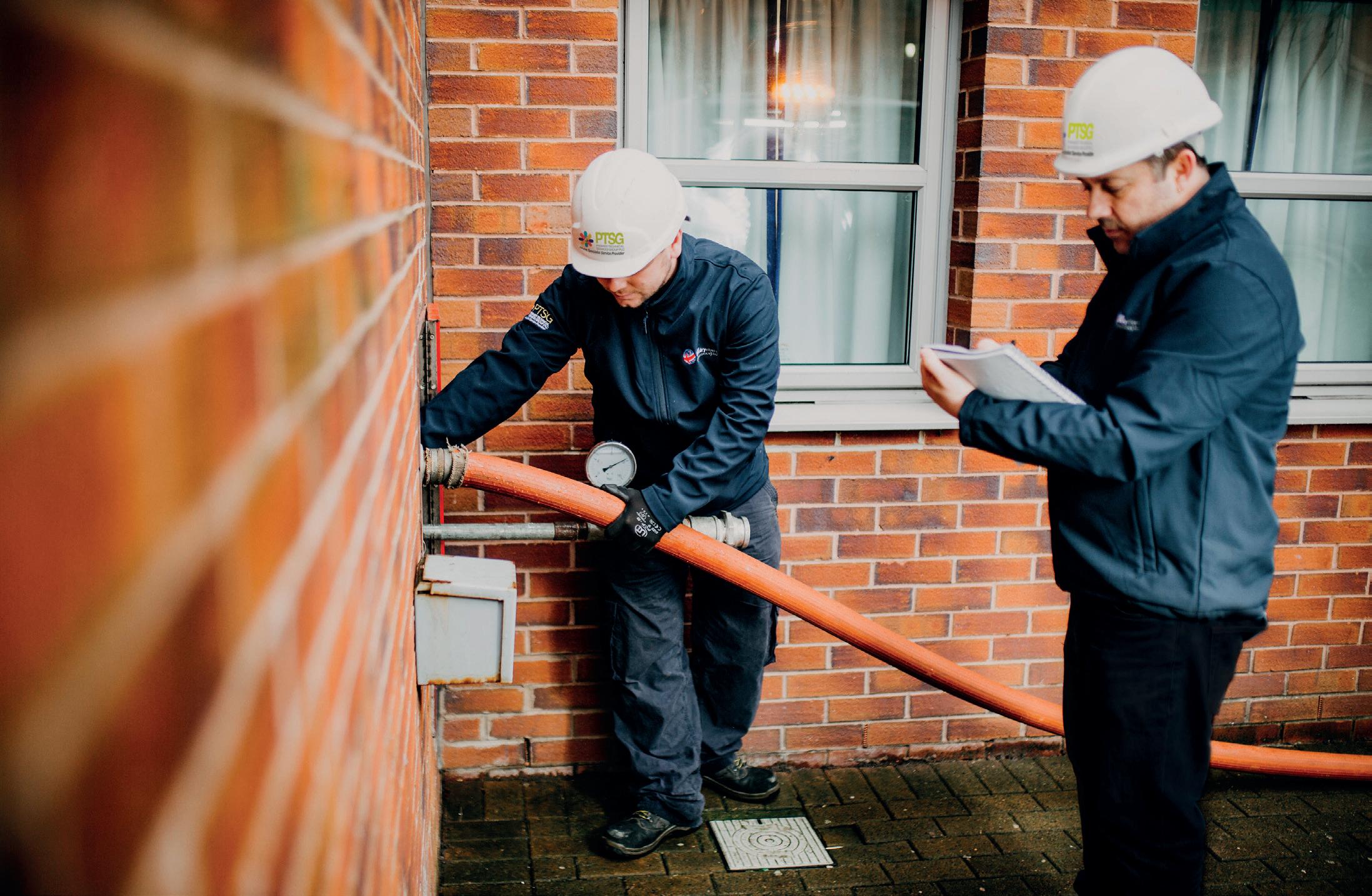
Facilities that are compliant work more efficiently. Regular maintenance reduces the chances of breakdowns and the potential for expensive downtime. Compliant systems also align with best practice.
Regular compliance audits help to highlight any areas for improvement in the running of a building. Therefore, being compliant enhances the operations within. A programme of planned preventative maintenance (PPM) can head off problems before they occur, which could save untold costs as well as accidents.
Compliance plays a crucial role in shaping an organisation’s reputation, as it demonstrates commitment to decent and moral business practices, regulatory adherence, and corporate responsibility.
This reassures customers, investors and partners that an organisation operates transparently and honestly.
A commitment to compliance also differentiates an organisation from competitors with poor ethical records.
Ethical compliance aligns with social responsibility, enhancing public perception. As ESG (Environment, Social and Governance) is now top of every responsible organisation’s agenda, being compliant is a central part of a sound ESG strategy.
PTSG takes a collaborative, “partnership” approach to working with its customers, ensuring compliance in all of the five main areas of specialist services it delivers (Access & Safety, Electrical Services, Façade Cleaning and Maintenance, Fire and Security Solutions and Water Treatment). The outcome – in addition to making their buildings safe and efficient, protecting their people and reputation – is invariably to give them a competitive advantage. Compliance opens up opportunities in regulated industries and global markets.
To talk to one of our specialists about your building requirements, please contact: sales@ptsg.co.uk | 01977 668771 | ptsg.co.uk
Compliance plays a crucial role in shaping an organisation’s reputation







For men dealing with health challenges such as prostate cancer and incontinence, the impact goes far beyond the physical experience. It also has a significant effect on mental health with men facing these issues often experiencing profound stress, anxiety, and low self-esteem

The phs Group has been working with organisations such as Prostate Cancer UK to promote open dialogue and offer resources aimed at breaking down the stigma of male incontinence and creating a supportive environment for all men.
FM Director ’s Claire Middleton recently caught up with Robin White, phs Group’s Chief Commercial Officer, to learn more about the BOG STANDARD campaign and what else is keeping him busy right now.
The BOG STANDARD campaign aims to tackle these issues by pushing for inclusive, well-equipped washrooms for men. phs Group has worked tirelessly to boost awareness, release impactful whitepapers that outline the scale of the issue, and encourage businesses to integrate these supportive and inclusive facilities into their buildings.
How BOG STANDARD came about phs Group began building a relationship with Prostate Cancer UK just under two years ago. “One of the things that became really apparent through that relationship is how stark the stats are,” Robin explains.
“One in eight men are likely to experience prostate cancer at some point in their lives and that rises to one in four for black men. Two thirds of those that receive life-saving treatment will become incontinent.
“We found that there was very little focus on aftercare and how survivors can lead as normal a life as possible after treatment.
“One piece of research we did with Prostate Cancer UK at the
78% of men feel anxious about accessing disposal facilities when leaving home.
64% of men have not been able to attend major life events due to their incontinence.
34% of men find it hard to locate a bin in public toilets.
end of last year was focused around sports stadiums and football fans and it was discovered that men were not going back to sports after illness because there was nowhere for them to dispose of their incontinence products in privacy or with dignity. That’s where the ‘Back in the Game’ campaign began.”
Robin added: “We want to change this by starting a national conversation and removing the stigma. We want to encourage all public facilities and workplaces to provide incontinence bins in male toilets, because the problem reaches further than football stadiums.
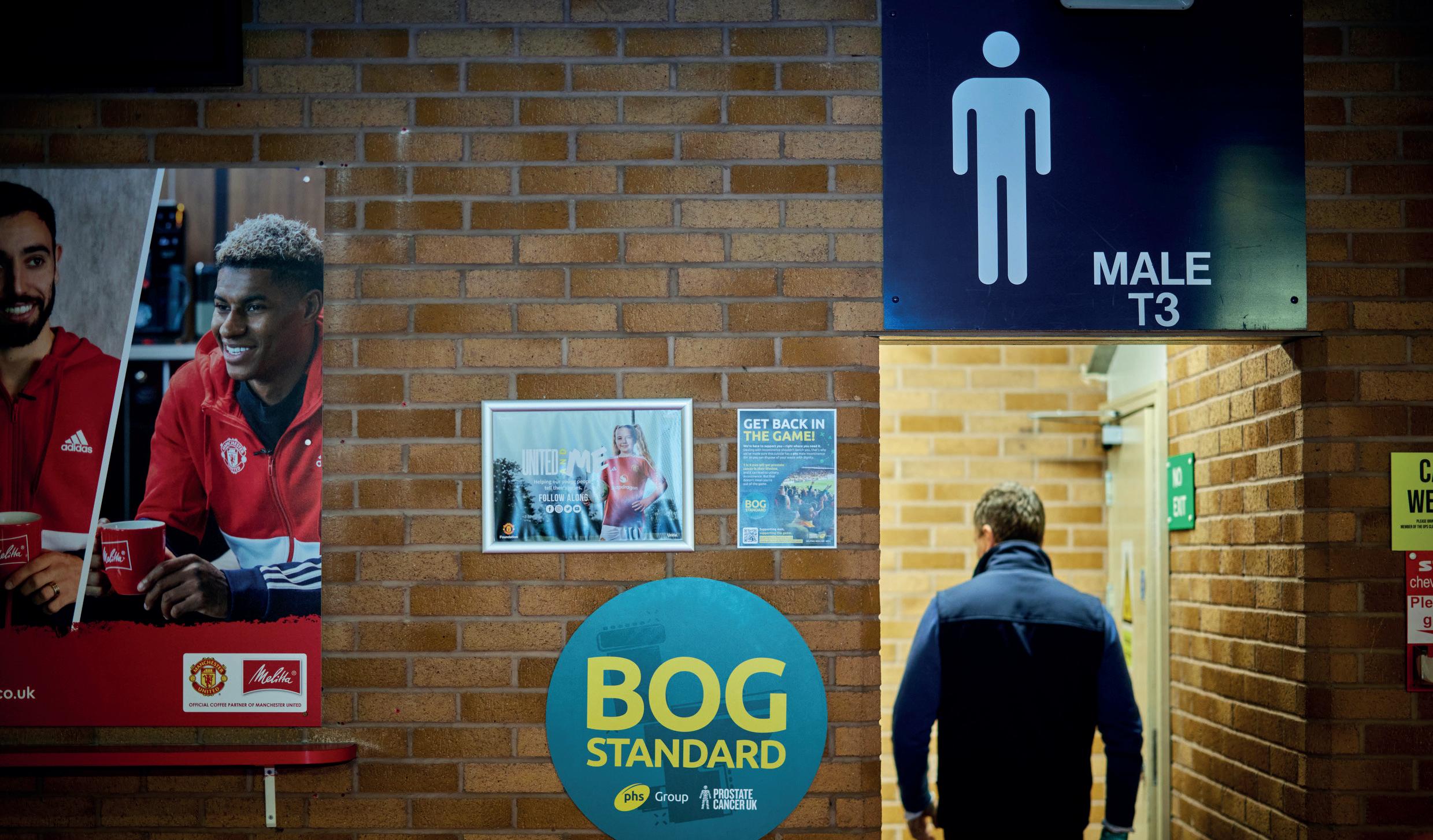
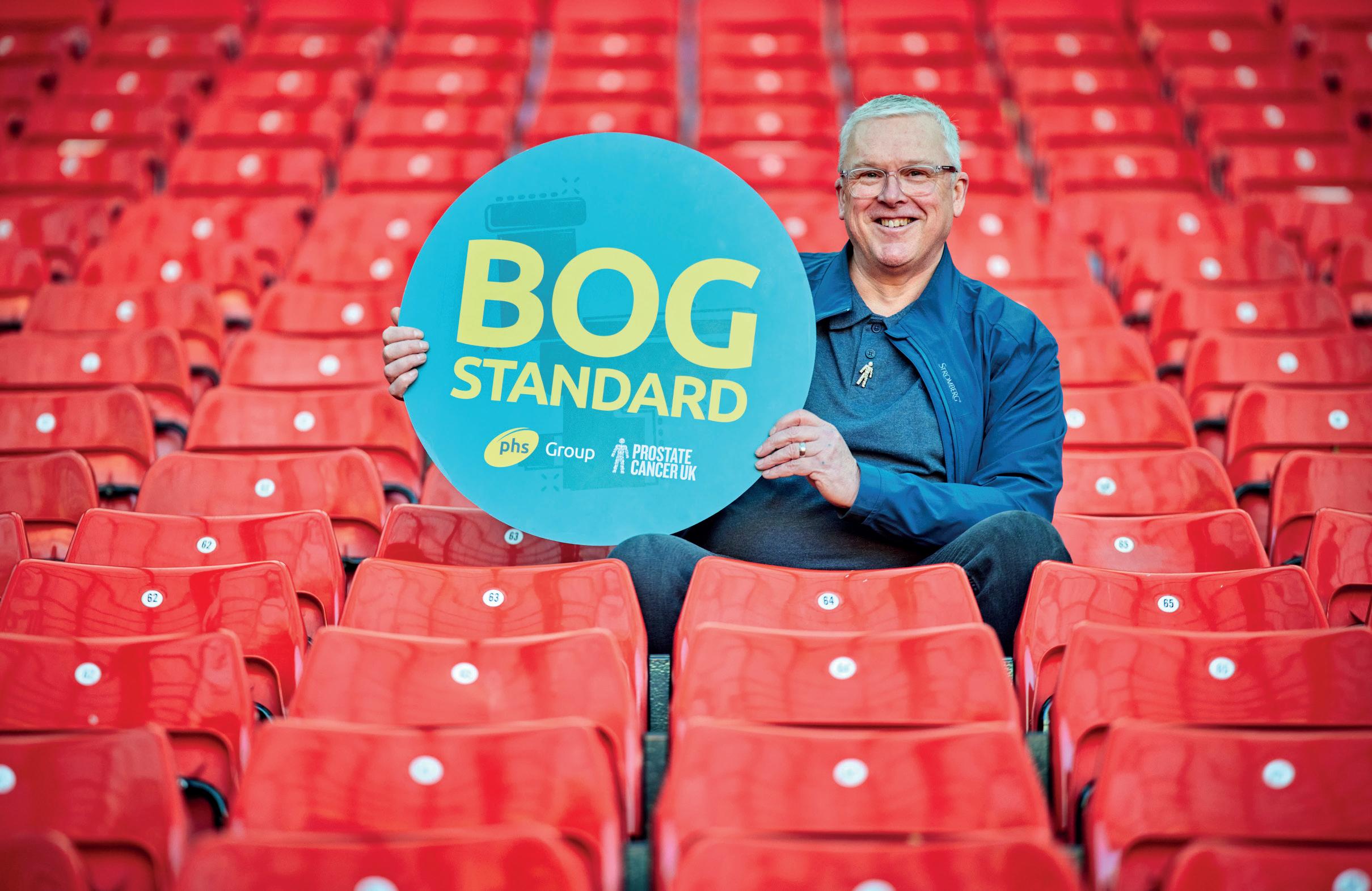
“It affects a huge range of places such as motorway services, offices, shopping centres, leisure venues and many more.”
Robin is ‘delighted’ with how the campaign is going so far. He said: “It’s really grabbed the attention of the media, and we’ve now placed over 18,000 male incontinence bins across the UK.”
As BOG STANDARD campaign gathers momentum, more and more businesses are taking notice. Manchester United signed up to be the Premier League’s first Gold BOG STANDARD club in November, following the release of stats that showed football fans across the UK were missing out on attending live matches because of incontinence.
In a news article released around the same time, phs Group talked about how the challenges men face was highlighted in a film about lifelong Manchester United fan, Mark Farrington.
Mark, a 56-year-old repairs planner, from Horwich in Greater Manchester, was treated successfully for prostate cancer aged 54 but was left incontinent for a period of time.
He said: “You worry constantly – will I leak, will I be able to find anywhere to change my pad? Going to a football game was out of the question. Having bins for me to have been able to dispose of my incontinence pads would have made such a difference to me. You’d know you have somewhere to put it – I would 100% have gone to some games if things had been different, and that would have really helped me to feel back to my old self.”
The gold BOG STANDARD means that men can now visit Old Trafford safe in the knowledge that the toilets will have male incontinence bins and products, such as pads. The club has installed 71 bins across the ground, with each washroom clearly signposted so that men can quickly and easily identify where they can find a male incontinence bin. The club will also be promoting awareness about prostate cancer and incontinence.
“Getting a business like Manchester United on board is only going to help the cause,” Robin said. “It shows how serious businesses are taking the issue. We are already in several conversations with FM businesses about how they can roll it out across the UK and so I’d urge anyone who’s interested to get in touch.”
“Getting a business like Manchester United on board is only going to help the cause. It shows how serious businesses are taking the issue
Men need more support in the washroom to dispose of incontinence waste.
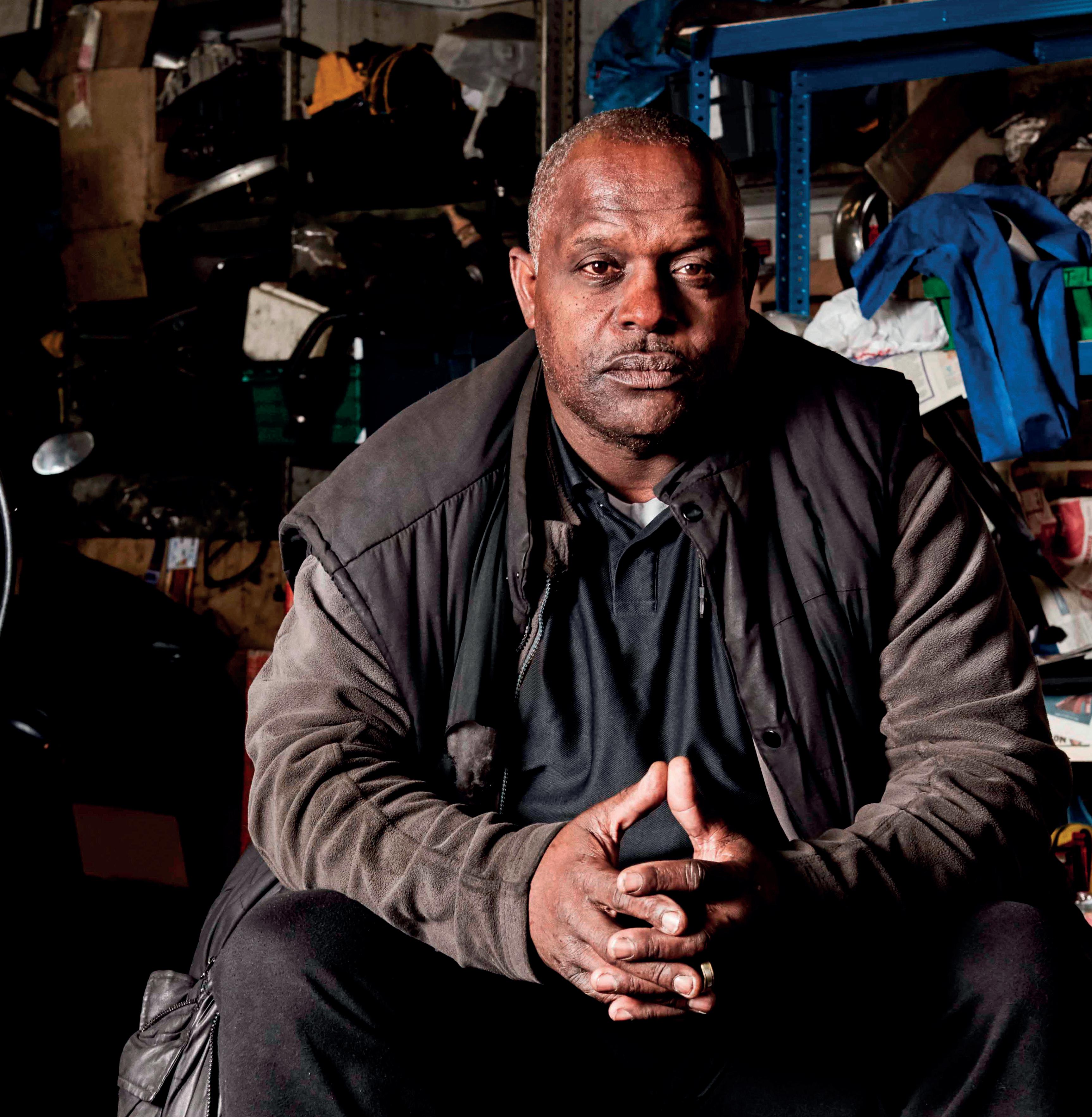

1 in 8 men, rising to 1 in 4 in black men will get prostate cancer in their lifetime. Help men
Dispose with Dignity with phs Male Incontinence Bins. Let’s help men live well.



How facilities managers can get involved with BOG STANDARD
Robin explained: “If they have an account manager already, FM businesses can speak to them, and they will guide them through the different options available. If they don’t have an account manager, they can simply visit our website for more information.”
And the cost to businesses? Robin says there’s no need to fear as it’s not a costly commitment at all. “It’s very cost-effective,” he says. “Even more so if phs Group is already visiting your premises for other reasons, it’s just one more product to be added to the service, and it will be competitively priced accordingly.”
So, what else is keeping Robin and the team busy right now? “Our job is to support our FM customers, and in the immediate term, we’re aware that the consequences of the recent budget are at the forefront of a lot of our customers’ minds,” Robin explained.
“We’re focused on helping our customers navigate their way around the cost increases that have been announced surrounded national insurance and national minimum wage.
“I’d say that’s the most immediate pressure, but the ongoing focus is on making sure that sustainability remains at the forefront of all our customer conversations. It’s vital to keep looking at how we can support their businesses to be able to provide sustainable solutions to their clients.
“We’ve got a carbon calculator to help our customers see how much waste goes to landfill or to EFW. With the landfill tax increasing from the beginning of April, it’s another pressure that businesses are facing.”
For more information about phs Group and the BOG STANDARD initiative, please visit phs.co.uk

The all-new FMBD newsletter
Monday
Hard services and construction focus
Wednesday
Soft services focus
Friday
A combo of the week’s biggest stories, video interviews and exclusive features from across the FM industry


Security and sustainability may not immediately appear intertwined, but organisations need to collaborate with all supply chain partners to meet ever-looming sustainability goals. Developing decarbonisation strategies, ESG commitments and social value service offerings all strengthen organisational partnerships and business cases. Sharon McLaren, quality and compliance manager, Corps Security, tells us more…
The Paris Agreement’s international treaty on climate change aims to limit the global temperature increase to 1.5 °C degrees above preindustrial levels.
Crossing this threshold would have a devastating impact on climates everywhere – from more frequent droughts to increased heatwaves and rainfall.
Across the FM sector, organisations need to work together to address climate concerns against ever-looming CO 2 reduction targets. Some businesses need them to be met by 2050, others 2040, and some as soon as 2030.
The Government wants to prioritise renewable energy and help businesses decarbonise efficiently to reduce levels of CO2. However, for businesses to reach these targets, they must not only review their own CO2 emissions, but also those emitted by their suppliers.
Areas for supplier reduction like manufacturers, vehicle fleets, and estate assets may all immediately come to mind – but the sustainable practices of service providers such as security companies should not be overlooked.
Like any business, the scope 1, 2 and 3 emissions of security organisations, their decarbonisation methods and social value commitments need to be core considerations in clients’ procurement decisions. A collaborative approach between client companies and security partners is essential for embedding the most worthwhile sustainability practices – and this expands far beyond environmental practices encompassing social sustainability too.
Both environmental and social sustainability are a critical part of underpinning every business partnership.
Environmental sustainability needs to be a scientific, empirical, and fundamental part of any business strategy. Security partners can provide their status by collating raw data themselves, but it’s best to ask for support from the experts.
External organisations can help meticulously track all emissions and develop decarbonisation strategies. Neutral Carbon Zone (NCZ), for example, offers measurement tools and net zero certification.
At Corps, our partnership with NCZ has helped us redevelop our organisational carbon footprint reporting.
Environmental sustainability needs to be a scientific, empirical, and fundamental part of any business strategy

We achieved the NCZ Gold accreditation, submitting scope 1, 2 and 3 emission reports against the NCZ framework and reporting to the ISO 14064 compliance standard.
As a result of this activity, our scope 3 footprint, the total emissions of organisations indirectly affecting our supply chain, changed.
Our footprint increased by several thousand tonnes more than previously reported.
Though this may at first seem like a regression, this was due to more in-depth reporting methods to effectively track the right things and therefore be able to improve them.
NCZ guided us to be as transparent as possible, and in doing so we built trust and a strong partnership.
Corps proposes the Real Living Wage payment at all new contract negotiations
Organisations such as NCZ can also provide transparency on very granular emissions produced by security and client partnerships. For example, lifecycle analysis can provide site-specific carbon reporting, including the emissions from on-site officers.
These reports bolster security partners’ credentials and ESG offering at the tendering and contract renewal stages.
Organisations like the Science Based Targets initiative (SBTi) and EcoVadis also offer well-known carbon reduction programmes. SBTi is a corporate climate organisation that provides standards, tools and guidance to help organisations set greenhouse gas emission reduction targets.
EcoVadis supports environmental, social and governance risk and compliance, to develop scorecards and catered ecosystem and improvement platforms.
Together, these programmes are invaluable in allowing supply chain partners to produce in-depth, accurate reports on all emissions.
These not only guide organisations on their next decarbonisation steps but also provide much-needed clarity and direction for new business partnerships.
Though security officers on the ground are not guiding the organisation’s ESG strategies, engaging with them is a crucial way to bolster a sense of community, and encourage them to support the organisation’s ESG goals, and educate them to make changes in their personal lives.
For security organisations, patrolling on foot is a large part of a security officer’s role. We have introduced Treekly, a step-counting app that encourages all staff to walk more.
The app allows a mangrove tree to be planted in Kenya for every 20 days of 5,000+ steps walked.
These apps are accessible and easy-to-use for frontline workers who often do not have access to a desktop.
They promote healthy behaviours amongst colleagues and can even develop friendly competitions with clients at certain sites –helping to push each other to new healthy heights and create a positive impact overseas.
Along with carbon neutral initiatives, security providers can strengthen organisations’ social value commitments at the tender stage. For example, supply chain partners should always advocate for fair pay – Corps proposes the Real Living Wage payment at all new contract negotiations.
Charity partnerships also strengthen business commitments. Corps’ 1% scheme is a voluntary programme for our clients that sees a 1% surcharge on their contract value which is donated to Combat Stress. This has amounted to over £30,000 in previous years.
Providing employees with yearly volunteering days also allows them to prioritise their local communities through their employer, in the spaces that matter to them the most. In 2024, Corps held activities to raise over £50,000 – from walks and cycling, to marathons, our teams across the UK took part in friendly competitions and group challenges to raise money for a range of organisations.
Accreditations, and environmental and social value schemes are all ways to embed sustainability into the DNA of an organisation. But it’s important to never stop being curious and continue to explore new ideas. For example, explore new technologies that increase efficiency – like heat pumps, options for uniform recycling and wastepaper management strategies. There are many possibilities, but their implementation hinges on one key factor – strength across a supply chain and a shared goal to do better for people and planet.
Strong relationships between security providers and clients can be a powerful catalyst for reimagining more sustainable practices and a better future.








Integral Cradles, a leading façade access installation company, has taken a major step in its sustainability journey by achieving Carbon Footprint Certification, confirming its carbon neutrality
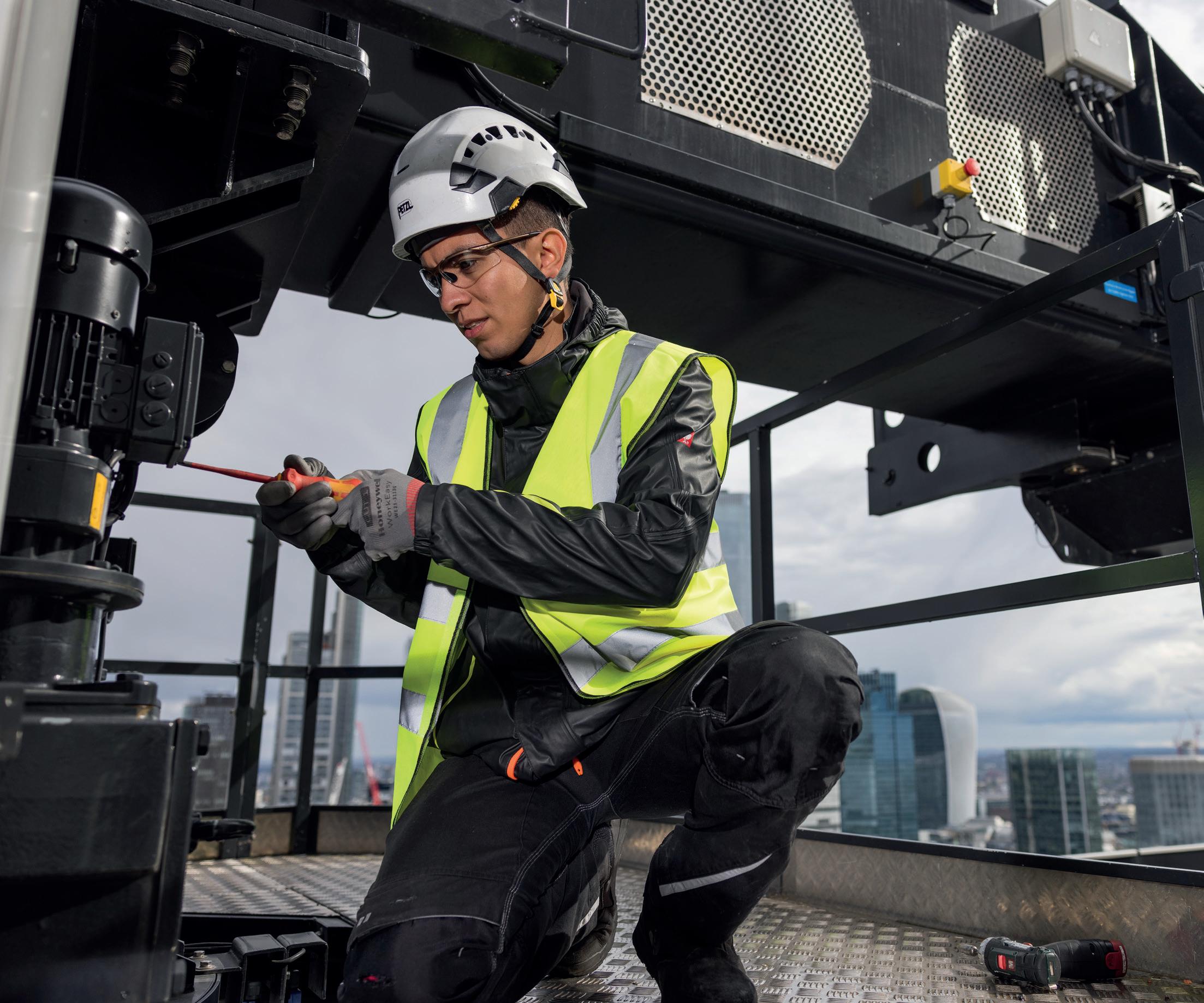
The construction industry plays a huge role in the world’s carbon output, with around 40% of all man-made global carbon emissions coming from construction and operation of buildings.
In recent years Integral Cradles and its maintenance partner GIND UK have invested heavily in reducing their impact on the planet. Last year, Integral Cradles partnered with Carbon Footprint Ltd, a globally recognised carbon emissions management company, to assess and offset its environmental impact.
Through this collaboration, Integral Cradles has supported a variety of international carbon reduction initiatives, particularly those benefiting local indigenous communities and ecosystem restoration efforts. This milestone reflects the company’s commitment to measuring, reducing, and offsetting carbon emissions, positioning it as a frontrunner in environmental responsibility within the construction sector.
Discussing the certification, Kevin Walton, managing director of Integral Cradles said: “Achieving carbon neutrality is a proud moment for Integral Cradles and a testament to our long-term commitment to sustainability,”
“Working with Carbon Footprint Ltd has allowed us to take meaningful action in reducing our emissions while supporting impactful global projects that restore ecosystems, enhance biodiversity, and empower local communities.”
Global carbon offset projects
As part of its Carbon Footprint partnership commitment, Integral Cradles has contributed to several verified carbon offset projects, including:
Reforestation in Peru
A project supporting the recovery of the Amazon dry forest through the Urku Amazonian Studies Reforestation Project. This initiative works with local indigenous community co-operatives to restore native forests, particularly through the planting of the Maya Nut tree.
‘Guanaré’ Forest Plantations in Uruguay
An initiative aiming to restore degraded grasslands by planting new forests in previously treeless areas, following FSC sustainable forest management standards. This project enhances biodiversity while creating economic opportunities for local communities.
Zhangye Improved Grassland Management in China
A scheme focused on restoring degraded grasslands in Zhangye through seeding and sustainable grazing practices. The project has been certified under the Climate Community and Biodiversity Standard (CCB) and the CORSIA Pilot Phase for carbon removal.
In numbers: Measuring and offsetting carbon impact Integral Cradles’ carbon footprint assessment, conducted using DEFRA guidelines, included Scope 1, Scope 2, and selected Scope 3 emissions, totalling 11.99 tCO 2e (market-based) and 12.90 tCO 2e (location-based) for the 12-month period ending August 31, 2024.
To offset its emissions, Integral Cradles invested in verified carbon reduction projects, neutralising a total of 12 tonnes of CO 2e.
A long-term sustainability commitment Beyond carbon-neutral certification, Integral Cradles remains dedicated to ongoing carbon reduction efforts while continuing to champion innovative sustainability practices in the construction industry.
With a wider Net Zero strategy in place, the company is taking the following steps to address reducing its Actual Carbon Emissions (ACE):
Reduce:
Implement energy efficiency solutions in our workplaces
Consistently adopt lean construction techniques and prefabrication
Make more low-carbon travel choices available
Incentivise low-carbon travel choices
Optimise materials and reduce waste through smart design
Water used in installations/ commissioning
Transform:
Aim to procure 100% renewable electricity
Specify usage of hybrid and electric plant and equipment
Promote the adoption of modern methods of construction (using BIM and other technologies)
Consistently adopt lean construction techniques and prefabrication
Make more low-carbon travel choices available
Incentivise low-carbon travel
Investigate:
AI and IOT platforms
Zero carbon travel provider
New commissioning processes
Design for disassembly
Achieving carbon neutrality is a proud moment for Integral Cradles and a testament to our long-term commitment to sustainability

Influence:
Clients to adopt low-carbon strategies
Suppliers to provide low-carbon solutions
Share benefits/case studies of flexible working
Designer partners, suppliers, logistics partners
together
With carbon neutrality certification now confirmed, Kevin says the next steps for Integral Cradles is to eliminate all Scope 1, 2 and 3 emissions to become a fully net zero carbon business by 2030. To achieve this goal, he believes working with the wider industry is essential:
“This certification is a fantastic milestone, but it’s only the start of our journey. Our long-term strategy is to drive real, measurable reductions in our carbon footprint and achieve net zero by 2030.
“We are committed to embedding sustainability at every level of our operations, from how we source materials to the way we work with partners and clients to create a greener built environment.”
He added, “We are not alone in the climate crisis, it’s a collective challenge for the industry. To succeed we must see it as an opportunity to collaborate and innovate, developing solutions that will help our planet survive.
“We urge our clients, partners, and industry peers to join us in find better, greener ways to work, to make the world a better place for future generations.”
For more information about Integral Cradles’ sustainability initiatives and its roadmap to net zero, visit” chrome-extension: www.i-cradles.com/wp-content/ uploads/2024/10/IntegralCradles_NetZero-2.pdf









When a glass panel recently plummeted from Glasgow University’s 30-metre-high roof, narrowly missing pedestrians below, the incident highlighted a critical challenge in modern facility management: how to maintain increasingly complex building structures while ensuring public safety and minimising disruption. The solution came from an unexpected blend of old-world craftsmanship and cutting-edge technology.
Pendrich Height Services, a company with roots in traditional steeple-jacking, deployed a team that combined time-honoured techniques with modern rope access methods to secure the site.
Rather than opting for conventional scaffolding that would have required road closures and disrupted the busy bus route below, the team utilised innovative modular cantilever scaffolding and specialised netting systems to make the building safe while keeping the thoroughfare open.
This approach exemplifies a broader transformation in the building maintenance industry, where traditional skills are being reimagined for modern challenges.
“The industry has evolved dramatically from the days of cloth caps and ladders,” explains Mark Perfect, whose company Pendrich has spent over five decades at the forefront of height access solutions. “Today’s challenges require us to blend traditional steeplejack expertise with cutting-edge technology and innovative access methods.”
The journey from traditional steeplejacking to modern height access solutions mirrors the evolution of our built environment. As buildings become more complex and safety standards more stringent, the methods for maintaining them have had to adapt. Pendrich’s story illustrates this transformation, having grown from a small family business in a Scottish coal village to become the only company in the industry with IRATA company accreditation.
This evolution is perhaps best demonstrated in their work on iconic structures like Blackpool Tower. The Grade I listed landmark requires regular maintenance to preserve its historic integrity while meeting modern safety standards. Here, IRATA-trained engineers employed a combination of traditional techniques and modern rope access methods to conduct complex structural maintenance, ensuring the tower remains both safe and true to its heritage.
Today’s challenges require us to blend traditional steeplejack expertise with cutting-edge technology and innovative access methods
One of the most significant advances in the industry has been the development of new access systems that reduce costs and minimise disruption. Pendrich’s lateral access system, developed in response to client needs, provides a cost-effective way to access large roof undersides without the need for extensive scaffolding or disruption to building operations.
The company has also embraced digital transformation, implementing advanced operational management systems that provide real-time project tracking and detailed digital reporting.
This technology integration allows facility managers to monitor work progress, access comprehensive documentation, and maintain transparent communication throughout projects.
Today’s facility managers face a unique set of challenges: maintaining aging infrastructure, ensuring compliance with evolving safety standards, and managing costs while minimising operational disruption. The solution increasingly lies in finding service providers who can combine multiple disciplines and approaches.
Take the case of Celtic Park Stadium, where regular inspection and maintenance of the roof support structure is crucial for fan safety. Traditional access methods would have been costly and timeconsuming.
Instead, Pendrich developed a bespoke solution combining rope access techniques with specialised inspection methods, completing the work during the off-season with minimal impact on stadium operations.
As buildings continue to grow taller and more complex, the future of height access lies in this fusion of traditional skills and modern innovation. The industry is seeing increased adoption of drone technology for initial surveys, digital twin modelling for planning complex projects, and advanced materials for safer, more efficient access solutions.
However, the human element remains crucial. “While technology has transformed our capabilities, the core skills of working at height – the understanding of structures, materials, and safety requirements – remain as important as ever,” notes Perfect. “It’s about combining the best of both worlds.”
For facility managers and building developers, this evolution means access to more efficient, safer, and less disruptive maintenance solutions. The key is finding partners who can bring together traditional expertise with modern innovations to tackle the unique challenges of each project.
As our urban landscape continues to evolve, the ability to maintain and preserve our buildings – from historic monuments to modern skyscrapers – will depend on this sophisticated blend of old and new.
The steeplejacks of yesterday have evolved into the height access specialists of today, equipped with both time-tested knowledge and cutting-edge solutions for tomorrow’s challenges.
To find out more about Pendrich, a PTSG company, visit www.pendrich.com
With winter weather in the UK switching from sunshine to snowstorms in a matter of days, businesses are being reminded to prepare for extreme conditions to safeguard their people, assets, and operations
The winter season brings additional workplace risks due to wet, windy and icy conditions.
Tom Armenante, Director at GTSE, shares expert tips for businesses to protect against winter weather hazards.
In a new Winter Weather Guide for Businesses, GTSE, a leading supplier of industrial and safety products, shares practical steps to help UK businesses reduce risks, minimise financial impact, and avoid operational disruptions caused by harsh winter conditions.
The Financial and Safety Risks of Unpreparedness
Severe weather can inflict serious damage on buildings, equipment, and goods, both on-site and in transit. From storm-related structural failures to icy car parks that jeopardise employee safety, the cost of doing nothing can be significant. Additionally, unexpected closures due to poor weather can damage a company’s reputation and lead to lost productivity.
Commenting on this risk and why it needs to be taken seriously, Tom said: “Preparation is key for protecting your business premises during a storm but, it’s not just about the physical space and equipment. Businesses and their teams have a duty to look after their people, whether that’s staff, customers or other stakeholders, with human life being the number one priority.


“Simple steps like inspecting roofs, gritting pathways, and securing outdoor signage can save businesses thousands in repair costs, prevent workplace accidents and allow for business continuity. As we see more unpredictable weather globally due to climate change, the UK is likely to see greater extremes too. According to the Met Office, the UK saw temperatures in the Scottish Highlands reach -18.9°C, making it the coldest night in January for 15 years.”


15 ways to prepare your business against winter weather extremes
The comprehensive guide outlines a wide range proactive measures businesses can take to reduce winter weather risks, with some of the most effective being listed below.
1. Monitor weather forecasts – Staying informed about local and national conditions provides valuable time to prepare for storms.
2. Prioritise safety – Don’t hesitate to close if severe weather threatens lives. Productivity isn’t worth risking human safety.
3. Provide resources – Ensure that your teams have protective clothing, warm clothing for outdoor work, and supplies like rock salt and wet floor signage as needed.
4. Service equipment regularly – Preventive maintenance is cheaper than repairs. Check building systems, vehicles, and critical equipment regularly and not just in response to a poor weather forecast.
5. Prepare for power outages – It is often sensible to turn off water, gas, and electricity where feasible. Backup generators may be necessary for some businesses to ensure continuity and safety, so weigh up the pros and cons of doing this.
6. Plan for service delays – Anticipate disruptions to waste collection, deliveries, and logistics, and establish contingency plans to reduce risk whilst keeping things moving as much as possible.
7. Consider offsite risks – It isn’t just your premises that are at risk. Poor driving conditions can endanger your team’s commute and any workers who are offsite for business purposes. Evaluate the weather and conditions, allowing flexible or remote working where possible.
8. Conduct training and risk assessments – Empower all employees to report hazards, like leaks or icy parking lots. Having a clear process for this which is easy to follow, will encourage engagement, making safety a team issue.
9. Review insurance policies – Comprehensive insurance coverage is a must for any business. Ensure you have the appropriate coverage for buildings, contents, and stock to provide a financial safety net. Should you need to claim, photograph any damage to be used as evidence if required by your coverage provider.

Simple steps like inspecting roofs, gritting pathways, and securing outdoor signage can save businesses thousands in repair costs
In addition, during periods of heavy rainfall weather is expected businesses should…
10. Inspect building exteriors – Cracked roof tiles, damaged brickwork, and loose pointing all allow water to penetrate a building. Checking and fixing these vulnerabilities will help to prevent leaks and a build up of mould.
11. Seal windows and doors – Refresh the sealant around these fittings to keep water out. Remember to keep windows and doors closed during any storms too, forgetting to close a window fully could be a costly mistake.
12. Clean gutters and drains – Blockages in gutters and drains can cause overflows that lead to water damage. Clear any debris regularly and look for signs of potential problems. For more complex issues, you might want to hire in the professionals to guide you on the best solution.
13. Use sandbags and water pumps – Protect flood-prone areas with sandbags and pumps, diverting excess water away from your property and valuable equipment. You could also consider the building’s structure itself, installing things like airbricks.
14. Relocate valuables – Move any critical equipment and documents to higher ground where possible. I you can’t move everything, you could consider elevating items on bricks or tables.
15. Prevent slips – Keeping walkways mopped and dried where possible, adding mats with additional grip and placing wet floor signs out can all help reduce the risk of slips and falls.
By adopting these practical measures, businesses can avoid winter weather risks, protecting their employees and assets, and maintain smooth operations throughout the season. For a full winter preparation checklist, visit GTSE’s comprehensive guide.


FM Director will publish an overview of the industry’s latest senior new starters and details of their roles in each of its monthly publications

ISS UK & Ireland (ISS) has confirmed the appointment of Rebecca Jeffs as Chief People Officer, effective from 3 February.
The appointment follows a rigorous, impartial search process, which focused on finding a seasoned, capable candidate to underpin the delivery of ISS UK & Ireland’s ongoing, comprehensive transformation and to support the achievement of ISS’s global Signature Moves.
Rebecca succeeds Sandy Lucas, Director, People & Culture. Sandy, who joined ISS in January 2022, has accepted an opportunity to partner with her husband on a business venture unrelated to the facilities management industry.
Sandy Lucas will remain with the company until the end of February 2025, working alongside Rebecca to ensure an orderly transition of responsibilities.

The UK’s leading provider of returnable transit packaging, phs Teacrate has appointed a new Managing Director as it continues its rapid growth drive across the UK.
Teacrate has appointed Victoria Rhodes, who has over 17 years of experience in the returnable transit packaging (RTP) industry, including for one of Europe’s biggest market leaders. phs Teacrate, which has its head office in Southall, West London, provides high quality, RTP equipment for rent or purchase, as well as crate washing services to businesses across a range of sectors.
It is the UK market leader and provides a nationwide service with depots across the UK, including London, Bristol, Birmingham, Leeds, Manchester, Durham and Scotland.
Speaking about her appointment, Victoria Rhodes said: “phs Teacrate has a long, rich history in the industry, and I strongly believe that our team is the best in the business. This is an exciting new chapter for Teacrate, which we know will bring continued growth and success.”

White Oaks, the senior living division of Compass Group UK & Ireland, has appointed Laura Tighe as its Business Director. This comes as the team relaunch the offer, with a clear vision that encapsulates consistent high-quality food and services, with dedicated expertise.
Laura will take on responsibility for overseeing the strategy and operations across White Oaks. She joins from the position of Managing Director at Caterplus, with a wealth of experience and knowledge from 25 years working within foodservice. Over the last seven years, Laura has focused on, and developed a true passion for, supporting the Healthcare and Senior Living sectors – which drives her work with teams and clients.
Laura joins the wider team which includes Helen Ream, in her role as Dietitian and Lee Newton, as Business Development Director.






Hydrogen diffusion causes steel embrittlement and hazardous, costly loss of hydrogen. Not anymore with Tritonex hydrogen barrier coating.








No hydrogen leakage - the only proven hydrogen barrier coating with 100% effectiveness
Removes the risk of metal embrittlement
Simple application - retrofit or OEM application




The only solution for pipelines, storage tanks, fuel cells, etc.
Certified to ISO 17081:2014 (Hydrogen Permeation)











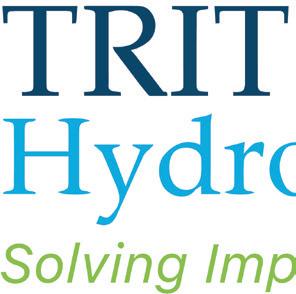





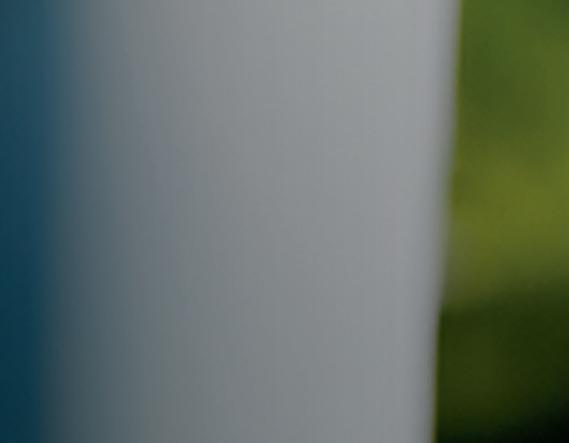






Spectrum Service Solutions, a leading independent cleaning and facilities management company, has announced changes to its management team. Former Operations Director Rebecca Bell has assumed the role of Managing Director, and former MD Sara Taylor (nee Speirs) is now Chair.
The changes continue the legacy of being a strong Scottish family business, staying true to its heritage, and at the same time aligning with its commitment to personal development and creating an inspiring workplace and an environment where people can thrive.
Sara Taylor founded the company in 2003, and it has grown year on year. It now has an annual turnover exceeding £16m and employs over 700 people working on daily cleaning contracts and at events throughout the UK.
Spectrum’s founder, Sara Taylor is also excited about the future; commenting on the changes, she said: “I’m delighted that Rebecca is taking the reins, allowing me to take a step back from the day-to-day operations. I have every confidence in her; she has all the experience and attributes to take the company forward. And we have a fantastic management team in place who I know will support her and drive the business forward.
SEP Drainage, a recently established name in the drainage and industrial services sector, has announced three pivotal leadership roles designed to secure what Company Director Rikki Morrow describes as a “strategic advantage” for the year ahead.
Mike Hampson and Cirk Newton both step in as Senior Operations Managers, overseeing the company’s drainage capabilities across the North West and North East of England, respectively.
Their combined industry background is expected to minimise disruptions on client sites and maintain the highest safety standards.
Rikki emphasised that the duo’s proven expertise will help projects progress swiftly and securely, stating, “Their track records bring exactly the level of commitment we need for operations, ensuring timely turnarounds and peace of mind for our clients.”


2024 was a landmark year for Sabert Corporation Europe. As a leader in sustainable foodservice packaging, the company is setting its sights on an even more dynamic 2025.
“Last year was a year of significant milestones,” says Alex Noake, the new Senior Vice President and Managing Director of Sabert Corporation Europe. “We launched three major product lines in 2024 and initiated development on several more, which we are eager to unveil this year.”
Sabert has always been a trailblazer in the foodservice packaging industry and the company’s innovation continued to be widely recognised in 2024. The Snap2Go range – a fully recyclable solution for chilled meals and food-to-go outlets – won the New Product category at the British Sandwich & Food to Go Industry Awards – The Sammies.
Later in the year, Tray2Go – a fully recyclable packaging solution for sushi, other chilled food-to-go, confectionery and bakery products – earned the prestigious National Gold Award in the Paper & Packaging Innovation category at the Green Apple Awards for Environmental Best Practice.


Over 7,000
people have connected with us on LinkedIn reaches 250,000 daily subscribers is read by
30,000 FM professionals monthly
We organise in-person and online roundtable events designed to sit you next to the people who matter most to you
Talk to us about how our websites, online sales activity and social media team can help you to win work 24/7
Let us take your work winning profile enhancement activities to a place that you don’t yet know exists! We drive enquiries!
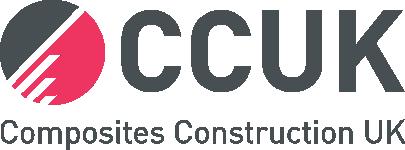
Specialist contractor Composites Construction UK operates throughout the UK and Europe. Using innovative methods, we carry out structural strengthening and repairs to concrete, timber, and masonry structures. contact@fibrwrap-ccuk.com www.fibrwrap-ccuk.com 01482 425250

Integral Cradles Ltd. delivers permanent façade access solutions across the UK, specialising in high buildings with unique specifications and demands. A whole life-cycle solution. kevin@i-cradles.com www.i-cradles.com 0845 074 2758
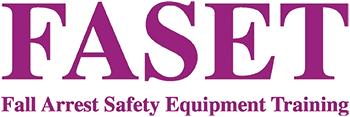
FASET is the established trade association and training body for the safety netting and temporary safety systems industry. We support members with guidance, training, and exclusive benefit schemes. enquiries@faset.org.uk www.faset.org.uk 01948 780652

For almost 30 years Julius Rutherfoord has been passionate about providing professional cleaning services to some of the most prestigious organisations in the London area. info@juliusrutherfoord.co.uk
https://www.juliusrutherfoord.co.uk/ 020 7819 6700

GIND UK delivers ambitious projects in challenging environments. Our London-based engineering and design team specialises in bespoke access system maintenance for the world’s most iconic buildings. info@gind.uk www.gind.uk
0800 448 8884

Lemon Contact Centre is a leading contact centre for the FM industry. Leveraging 20 years’ of expertise, our 24/7 contact centre services provide unparalleled flexibility, scalability and resilience for your business.
Lemoncontactcentre.co.uk
0800 612 7595

neutral carbon zone (NCZ) is a full-service platform that gives you the tools your company needs to make the transition to a carbon neutral business and beyond. gozero@neutralcarbonzone.com www.neutralcarbonzone.com
0845 094 5976

SAEMA has a long history in delivering the best training and guidance in the temporary and permanent suspended access industry. We are committed to advancing safety through raising the standards in best practice. info@saema.org https://www.saema.org/ 01948 838616
Project Management Global is a media platform and community for professional project managers. Providing informative news, industry insights, career support, resources and jobs for project managers across the globe. news.pm-global.co.uk

Seddon Management Services strives to offer the best solutions for trade associations to keep their members safe and compliant. becky@managementandauditing.co.uk www.seddonmanagementservices.co.uk 07854 226251
Premier Technical Services Group Ltd (PTSG) is the UK’s leading provider of specialist services to the construction and facilities management sectors. info@ptsg.co.uk https://www.ptsg.co.uk/ +44 (0) 1977 668 771
YorPower is one of the industry’s most trusted providers of back-up power solutions (generators and UPS) for customers in a wide variety of sectors, both in the UK and around the world. sales@yorpower.com www.yorpower.com 01977 688155


PTSG Fire Solutions Ltd offers an unrivalled breadth and depth of fire safety and security services.
With five independent business divisions delivering the full range of specialist services, PTSG ensures buildings of all kinds are safe, clean and compliant – in all sectors.


